the Coronavirus
WHO has announced the end of the epidemic of severe acute respiratory viral infection called Covid-19, and we can draw some conclusions.
Prevention. Attempts to create an effective mRNA vaccine against the virus that causes Covid-19 (SARS-CoV-2) have failed. All proposed products were unable to create either effective individual or collective immunity. Repeated regular injections were able to only briefly slow down the spread of infection, but not to cope with it.
The mRNA vaccines promoted by Big Pharma, unlike traditional vaccines with weakened or dead viruses, actually have the same, if not worse, effects than natural infection *. This was expected. Unlike infection, which produces antibodies to all varieties of the pathogen's proteins, mRNA technologies produce antibodies exclusively to the corona protein, which quickly mutates and thereby eludes the immune system. In the eternal pursuit of a new vaccine against a new variant of the virus, we are always in a losing situation.
Classic vaccines based on dead or weakened viruses, or their fragments, could produce antibodies to the entire spectrum of virus proteins, not just its crown protein. But such vaccines are used only in a small number of countries. The only reliable weapon against re-infection remains the immunity acquired as a result of infection.
Fortunately, the mortality rate from Covid-19 is quite low, and with the exception of certain groups of the population with underlying diseases, it is comparable to severe variants of seasonal influenza. And immune resistance lasts for at least a year * * *. The chances of re-infection in those who have been ill, especially in severe form, are quite low * *. Antibodies to a similar virus (SARS-CoV-1, 2003) have been detected in survivors of this disease for 17 years * * *. And even if the level of antibodies to SARS-CoV-2 falls faster * than to SARS-CoV-1, we should expect immune persistence in those infected for several years.
At the same time, the immune resistance of people vaccinated with mRNA vaccines drops to zero within six months *, and requires constant updating as new varieties of the virus emerge. Unfortunately, repeated vaccinations cause a phenomenon called «antibody-dependent enhancement of infection» (ADE) * *. As a result of ADE, vaccination has a negative effect: repeatedly vaccinated people are at higher risk of disease than unvaccinated people. The ability of beta-coronaviruses to provoke ADE * * * * has been the reason for the failure to create effective vaccines against MERS-CoV and SARS-CoV-1 *. Now the same story has repeated itself with SARS-CoV-2 *.
At the Doctors for Covid Ethics symposium (December 2021), Dr Sucharit Bhakdi and Dr Arne Burkhardt noted that the fundamental flaw underlying the development of mRNA vaccines against Covid-19 is ignoring the functional difference between the two main categories of antibodies that the body produces for protection against pathogenen *.
The first category of antibodies is secretory IgA. They are produced by immune cells (lymphocytes), which are located directly under the mucous membranes lining the respiratory and intestinal tracts. Antibodies produced by these lymphocytes are released through and onto the surface of the mucous membranes. Thus, these antibodies are located at the forefront of invading viruses, and they can prevent the virus from binding and infecting cells.
The second category of antibodies are circulating IgA and IgG. They are not located in place, but circulate in the bloodstream. These antibodies protect the internal organs of the body from viruses that have already entered the body and are trying to spread through the bloodstream.
If the virus fails to break through the immune defense thanks to the first category of antibodies, then it does not penetrate further into the body. Therefore, to avoid infection, we must activate antibodies precisely in those places where the SARS-CoV-2 virus most often penetrates into the body - on the mucous surface of the nose.
At the same time, vaccines are injected into a completely different place - into the muscle. When injected deep into the body, they are likely to induce primarily circulating antibodies rather than secretory ones. However, the task of circulating antibodies is not to repel the attack of viruses seeking to enter the body, but to trigger an immune response after infection. That is, they are unlikely to be able to fulfill the main task: to protect us from the invasion of viruses.
The proposed mRNA vaccines cause cells deep inside our bodies to express the viral spike protein. That is, vaccines force them to do things that they should never do by nature. Any cell that expresses this foreign antigen will be attacked by the immune system using both IgG antibodies and cytotoxic T lymphocytes. This can occur in any organ and the heart has been very commonly reported to suffer from such reactions *.
In addition, the body's response to an infection is different from its response to an injection. During infection, viral replication increases over several hours or days, involving one after another various echelons of immune defense as the disease progresses, before the viruses from the site of their invasion enter the blood and distant organs and tissues of the body. At the same time, with injection, 60-200 μg of spike mRNA (26-80 trillion mRNA molecules) are injected instantly. If each of these mRNAs can produce 10-100 spike proteins, and there are about 40 trillion cells in the body, then it seems possible that a larger systemic amount and much longer duration of exposure to spike protein through vaccination than through natural infection would be possible. In other words, when a vaccine is injected, many tissues and organs that could avoid this during a natural infection will be exposed to spike protein toxicity.
All this taken together leads to the conclusion that vaccination with mRNA vaccines, and especially booster vaccination, is a bad idea. Evidence of this is the large number of so-called «breakthrough infections». Vaccinated people continue to get infected and get sick.
Ultimately, even if the perfect vaccine is possible, it will take time to develop, produce and universally vaccinate it. All the while the virus will spread.
So, if the disease cannot be avoided, our task is to reduce its severity, and preferably at the expense of cheap, accessible, safe and natural means. Next, we look at the mechanism of the SARS-CoV virus cycle; we will briefly review the natural arsenal that can prevent infection and reduce the severity of the disease; and finally, we will try to make a herbal collection that can be used as an adjuvant therapy for any variation of the coronavirus.
Treatment. Treatment protocols may vary slightly between countries, but in general they include antiviral, anti-inflammatory and antithrombosis medications. Depending on the individual characteristics of the patient and concomitant diseases, additional measures may be required. Fortunately, the vast majority of cases of the disease are mild and herbal remedies can be used to treat it.
Attention! The text below is for discussion only. It reflects the personal opinion of the author and cannot serve as a guideline for treatment. The author assumes no responsibility for the consequences resulting from the practical application of the ideas discussed here.
Discussion platform is here.
The Severe Acute Respiratory Syndrome Coronavirus 2 can infect both humans and animals, and use the latter as a reservoir and laboratory for the production of new protocols. Examples include cattle, wild deer, pigs, rabbits, dogs, horses, camels, bats. Coronaviruses are carried over to the large Coronaviridae family. Their viral genome has a size of 27-32 thousand nucleotides, and is the largest among all RNA viruses, and their physical dimensions are 80-120 nm.
The SARS-CoV-2 genome contains 14 open reading frames (ORFs) encoding 27 proteins. The largest open reading frame, ORF1ab, encodes non-structural proteins, while the remaining ORFs encode four protein structures, namely glycoprotein aka spike protein (S), capture protein (E), membrane protein (M), and nucleocapsid protein (H).
The presence of a spike protein (S-protein, spike-protein), which is a corona particle on this surface of the virus, makes its structure even more unique than other viruses. These S proteins readily attach to angiotensin-converting enzyme 2 (ACE2) receptors on the surface of host respiratory cells, and bind extensively to the door opener of human epithelial cells.
Phylogenetic analysis shows that SARS-CoV-2 belongs to the same genus as the CoV that caused the severe acute respiratory syndrome (SARS) outbreak in 2002-2004 and shares 89% homology with SARS-CoV-1.
Based on this, as well as the general picture of the life cycle of all coronaviruses, it can be assumed that drugs that suppress SARS-CoV-1 will be quite effective against SARS-CoV-2 as well. In general, agents effective against other coronaviruses may also be considered against SARS-CoV-2. And vice versa.
Unlike bacteria, viruses do not have their own apparatus for replication, and use the apparatus of cells of living organisms for this. The coronavirus enters the human body by attaching its spike protein (S-protein) to ACE2 receptors present on the surface of epithelial cells. This can happen through the nose, mouth, or eyes, where the physical barrier is weakest. After docking to ACE2, the S protein interacts with enzymes present on the cell surface, starting a process that leads to the fusion of the viral and cell membranes.
As the virus fuses and enters the cell, the S protein is cleaved by the host cell's protease enzymes (either the plasma membrane protease TMPRSS2 or cathepsin B/L). Once inside the cell, the virus is completely released from the outer shell. Thus, the viral RNA is released into the cytoplasm and almost completely captures the host's replication apparatus for virus reproduction.
Two-thirds of CoV RNA is translated into two large viral replicase polyproteins, pp1a and pp1ab. (Translation is the production of proteins from RNA, and a polyprotein is a large protein that can be broken down into smaller proteins.)
To become active, these two polyproteins are cut by enzymes into 16 non-structural proteins (nsp), such as helicase and RNA-dependent RNA polymerase (RdRp). This work is carried out by viral enzymes: papain-like protease (PLpro) and chymotrypsin-like protease (3CLpro), otherwise called the main protease (Mpro). Using these viral replication enzymes, the viral RNA uses host cell machinery to produce new copies of viral proteins to replicate the SARS-CoV-2 genome.
After replicating the necessary material for subsequent assembly of the virus, its genome is encapsulated by an N-protein to form a nucleocapsid, and moved into the Goji cell complex for maturation. In this cell organelle, the nucleocapsid interacts with other structural components to form vesicles that are eventually released from the cell.
This completes the life cycle of the virus, and the army of its offspring is ready to infect other host cells in a new cycle.
Without delving into the wilds of this process *, we highlight the main stages of the life cycle of the virus, and determine the inhibitors of each of them * * (click on the arrow to expand the text).
In the block diagram above, blunt arrows indicate possible targets for the active components of medicinal plants, which are indicated by letters from a to az.
• Irreversible interference in the docking receptors of the virus: o – caftaric acid, p – chicory acid and echinacoside, q – vitamins D, C and Zn.
• Invasion blocking: a – emodin, b – lectins, c – quercetin, d – catechin, e – naringenin, f – hesperetin, g – baicalin, h – epigallocatechin, i – gallocatechin gallate, af – prodelphinidin, ag – gallocatechin, aj – saicosaponins, al – glycyrrhizin, am – licorice, ao – desmethoxyreserpine, ay – dihydrotanshinon I.
• Affinity for S-protein: an – eugenol, ay – dihydrotanshinon I.
• ACE2 receptor blocking: a – emodin, f – hesperetin, j – kaempferol, t – anthocyanins, phenolic compounds: aa – tannic acid, ab – 3-isotheaflavin-3-gallate, ac – theaflavin-3,3'-digallate.
• Blocking of the TMPRSS2 receptor: aa-[6]-gingerol.
• Endocytosis blocking: v – cinnamon butanol extract, ai – cinnamon procyanidins.
• Inhibition of 3CLpro: c – quercetin, j – kaempferol, y – curcumin, z – sinigrin, an – eugenol, ap – betulinic acid, aq – coumaroyltyramine, ar – cryptotanshinon, ao – desmethoxyreserpine, au – dihomo-γ-linolenic acid, as – lignan; at – sugiol; av – N-cis-feruloyltyramine; aw – tanshinone IIa.
• Inhibition of PLpro: c – quercetin, g – baicalin, j – kaempferol, n – myricetin, l – scutellarein, an – eugenol, aq – coumaroyltyramine, ar – cryptotanshinon, av – N-cis-feruloyltyramine, aw – tanshinon IIa, ax – moupinamide.
• Inhibition of the replicase-transcriptase complex: az – skullcap, n – myricetin.
• Inhibition of virus replication: k – aescin, j – kaempferol, s – resveratrol, af – prodelphinidin, ag – gallocatechin, ah – epigallocatechin isomers, ad – β-ocimene, 1,8-cineol, α-pinene and β-pinene, aa – tannic acid, ab – 3-isotheaflavin-3-gallate, ac – theaflavin-3,3'-digallate, ap – betulinic acid, ao – desmethoxyreserpine, as – lignan, and at – sugiol.
• Inhibition of virus release or assembly: aa – tannic acid, ab – 3-isotheaflavin-3-galalate and ac – theaflavin-3,3'-digallate, w – lectin-agglutinin.
• Inhibition of TNF-β, IL-1β expression: c – quercetin, m – luteoloside, x – chlorogenic acid, r – geranylated flavonoids (tomebrin A, B, D and E), s – resveratrol, t – anthocyanins, u – gallic acid, af – prodelphinidin, ag – gallocatechin, ah – epigallocatechin isomer.
The vast majority of studies on the antiviral activity of herbal remedies have been performed in Asia (mainly in China and India) on local material, few others have been performed in the rest of the world * *. Some of the components of these potentially useful plants, like the plants themselves, are exotic and are not available on the market due to their weak demand. Therefore, from the whole set of proposals, we will consider only the available ones.
Coronaviruses (CoV) enter the host cell through an interaction between the S-protein of the virus and the host cell receptor ACE2, which bind to the virus and allow it to enter the cell. The ACE2 receptor is highly active in the epithelial cells of the intestine, testes, lungs, kidneys, heart, and blood vessels. It is critical for the maturation of angiotensin, a hormone that regulates vasoconstriction and blood pressure, and therefore plays a key role in cardiovascular function as well as in the development of diabetes and hypertension *.
Inhibitors of SARS-CoV entry into the cell can do their job in two ways: 1) bind to the ACE2 receptor, and 2) bind to the virus. Both methods competitively hinder their docking with cell receptors and membrane fusion. The S-protein easily binds to ACE2 due to the fact that the reliefs of their surfaces coincide, just as the relief of a key coincides with the relief of a lock. Inhibitors play the role of debris that prevents the key from matching with the counterpart of the lock.
In addition, to enter the cell, the S-protein must be modified by proteases. Thus, inhibition of cathepsin and TMPRSS2 serine protease will also complicate the entry of the virus into the cell. The downside of this solution is that proteases are involved in the life of the cell, and their strong suppression can affect the functioning of the cell.
A list of some molecules and plants that exhibit in vitro the ability to inhibit the invasion of coronavirus into the cell through the ACE2 cellular receptor is given in the table below. Hereinafter, the term EC50 (effective concentration) is applied to cellular assays, while IC50 (inhibitory concentration) is applied to enzymatic or biochemical assays; units of measurement μM (micromoles) refer to the active substance, and μg/ml to its source. The † indicates substances that have been investigated specifically for SARS-CoV.
Source |
Latin Name |
Part |
Active substance |
IC50/EC50 |
Effect | Solvent | Links |
| Tuber ficeflower | Polygonum multiflorum | root |
emodin † |
30 μM, 5-10 μg/ml |
⇓ACE2 |
ethanol |
|
Nutgall tree |
Galla chinensis |
galls |
TGG † |
4.5 μM |
⇓S-protein |
ethanol |
|
Baikal skullcap |
Scutellaria baicalensis |
root |
luteolin † |
10.6 μM |
⇓S-protein |
ethanol |
|
Black cumin |
Nigella Sativa |
seeds |
thymoquinone † |
7.6 μM |
⇓ACE2 |
ethanol |
|
Rhubarb |
Rheum palmatum |
root |
emodin † |
18 μM |
⇓protease |
ethanol |
|
Onion |
Allium cepa |
peel |
quercetin † |
8.6 μg/ml |
⇓ACE2 |
ethyl acetate, water |
|
Ginkgo |
Ginkgo biloba |
leaf |
quercetin † |
4.5 μM |
⇓ACE2 |
acetic acid |
|
Thyme |
Thymus vulgaris |
oil |
complex |
27 μg/ml |
⇓ACE2 |
ethanol |
|
Wild leek |
Allium ampeloprasum |
bulb |
lectins † |
0.45 μg/ml |
⇓ACE2 |
water |
|
Ganoderma |
Ganoderma lucidum |
body |
ganoderic acid † |
4.7 μM |
⇓ACE2 |
water |
|
Liquorice |
Glycyrrhiza glabra |
root |
glycyrrhizin † |
300 μg/ml |
⇓ACE2 |
water |
|
Horse chestnut |
Aesculus hippocastanum |
seeds |
aescin † |
6 μM |
⇓ACE2 |
ethanol, water |
|
Cinnamon |
Cinnamomum verum |
bark |
procyanidins |
43 μM |
⇓ACE2 |
ethanol |
|
Turmeric |
Curcuma longa |
root |
curcumin † |
15 μM |
⇓ACE2 |
ethanol |
|
Pomegranate |
Punica granatum |
entirely |
punicalin † |
60 μg/ml |
⇓S-protein, ⇓ACE2 |
ethanol |
|
Cat's claw |
Uncaria tomentosa |
bark |
uncarine † |
6.6 μg/ml |
⇓ACE2 |
ethanol, water |
|
Baikal skullcap |
Scutellaria baicalensis |
root |
scutelarin † |
52 μM |
⇓ACE2 |
ethanol |
|
Baikal skullcap |
Scutellaria baicalensis |
root |
baicalin† |
2.24 μM, 25 μg/ml |
⇓S-protein, ⇓ACE2 |
ethanol, water |
|
Ginger |
Zingiber officinale |
root |
[6]-gingerol † |
NA |
⇓TMPRSS2 |
ethanol |
|
Cloves |
Syzygium aromaticum |
flower buds |
eugenol, krategic acid † |
NA |
⇓S-protein, ⇓ACE2 |
ethanol |
|
Cistus |
Cistus incanus |
leaf |
NA † |
NA |
⇓S-protein |
water |
|
Pokeweeds |
Phytolacca esculenta |
root |
esculentoside † |
NA |
⇓S-protein, ⇓ACE2 |
ethanol, water |
Of all the studied Chinese plant families, only six (Nelumbonaceae, Labiatae, Magnoliaceae, Oleaceae, Lauraceae and Polygonaceae) at a dose of 1 μg blocked S-protein binding to ACE2 by 60-90%; the family Polygonaceae stood out especially with an inhibition percentage of 86.3% *. In this regard, the mountaineer multiflorum and finger rhubarb look more attractive than other competitors.
While quercetin makes it difficult for the virus to bind to the receptor through competitive substitution, lectins bind to mannose-glycated SARS-CoV spike glycoproteins *, while elderberry polyphenols, kaempferol and emodin, as well as agglutins and propolis, directly bind to S-protein * *, worsening the most his chances of docking. Finally, cinnamon and blueberry polyphenols inhibit endocytosis *. Since they all delay the penetration of the virus into the cell in different ways, at least a cumulative effect can be expected from their combination.
Mannose-binding lectins contained in Leek (Allium ampeloprasum) show high anti-coronavirus activity in affected tissues *, however, lectins do not tolerate high temperatures, so they are not included in the composition of decoctions, but consumed raw. In addition, lactoferrin blocks the adhesion to cell receptors of both DNA and RNA viruses, both enveloped and non-enveloped viruses * * *.
Epithelial cells are covered with glycocalyx – mucus, consisting of oligosaccharides, monosaccharides, glycoproteins and glycolipids. A thick and sulfated layer of glycocalyx, like thick fur, covers cell receptors and mechanically makes it difficult for pathogens such as coronaviruses to dock with them. In addition, the sulfated glycocalyx has a negative electrical charge that repels similarly charged SARS-Cov viruses. Degradation of the glycocalyx or weakening of its protective function increases the risk of infection *.
N-acetylcysteine, as an effective sulfur donor, can be used for glycocalyx sulfation. In in vitro experiments, N-acetylcysteine increased the antioxidant capacity of cells, prevented virus replication, and suppressed the expression of pro-inflammatory cytokines in cells infected with influenza viruses and respiratory syncytial virus. In in vivo studies, N-acetylcysteine reduced mortality in influenza-infected mice *. A dosage of 600 mg/day of N-acetylcysteine would appear to be sufficient to produce a therapeutic effect.
The 3CLpro (aka Mpro) and PLpro proteases are enzymes that are involved in cutting the polyprotein into functional proteins. Protease inhibitors change or deactivate the configuration of proteases, thereby making it difficult to create structural proteins. A great many plant sources provide chemical compounds that exert antiviral activity by inhibiting the 3CLpro protease; for the most part, these are flavonoids. The greater the variety of flavonoids used, the greater will be the number of virus sites bound by them.
Source |
Latin Name |
Part |
Active substance |
IC50/EC50 |
Effect | Solvent | Links |
Horse chestnut |
Aesculus hippocastanum |
seeds |
aescin † |
6 μM |
⇓3CLpro |
ethanol |
|
Baikal skullcap |
Scutellaria baicalensis |
root |
baicalin † |
6.4 μM |
⇓3CLpro |
ethanol, water |
|
Baikal skullcap |
Scutellaria baicalensis |
root |
baicalein † |
0.9 μM |
⇓3CLpro |
ethyl acetate |
|
Baikal skullcap |
Scutellaria baicalensis |
root |
scutelarein † |
5.8 μM |
⇓3CLpro |
ethanol, water |
|
Green tea |
Camellia sinensis |
leaf |
isotheaflavin † |
7 μM, 8 μg/ml |
⇓3CLpro/RdRp |
water |
|
Creat |
Andrographis paniculata |
leaf |
andrographolide † |
6.8 μM |
⇓3CLpro |
ethanol |
|
Black tea |
Camellia sinensis |
leaf |
theaflavins † |
9.5 μM, 8 μg/ml |
⇓3CLpro |
water |
|
Ginkgo |
Ginkgo biloba |
leaf |
quercetin † |
73 μM |
⇓3CLpro |
ethyl acetate, water |
|
Woad |
Isatis indigotica |
root |
sinigrin † |
217 μM |
⇓3CLpro |
ethanol |
|
Woad |
Isatis indigotica |
root |
hesperetin † |
8.3 μM |
⇓3CLpro |
ethanol |
|
Aloe |
Aloe vera |
leaf |
aloe-emodin† |
8.3 μM |
⇓3CLpro |
ethanol |
|
Garlic |
Allium sativum |
oil |
allyl disulfide † |
NA |
⇓3CLpro |
ethanol, water |
|
| Ashitaba |
Angelica keiskei |
leaf |
xantoangelol † |
35/12 μM |
⇓CLpro/PLpro |
ethyl acetate |
|
Bergamot |
Citrus bergamia |
oil |
bergapten † |
0.35 μg/ml |
⇓PLpro |
ethanol |
|
Turmeric |
Curcuma longa |
root |
curcumin † |
40/5,7 μM |
⇓3CLpro/PLpro |
ethanol |
|
Sage |
Salvia miltiorrhiza |
root |
salvianol acid † |
NA |
⇓3CLpro |
ethanol |
|
Sage |
Salvia miltiorrhiza |
root |
tanshinons I,II † |
9/1,6 μM |
⇓3CLpro/PLpro |
ethanol |
|
Sage |
Salvia miltiorrhiza |
root |
dihydrotanshinon † |
5 μM |
⇓3CLpro/PLpro |
ethanol |
|
Cryptolepis |
Cryptolepis sanguinolenta |
root |
cryptospirolepin † |
NA |
⇓3CLpro |
ethanol |
|
Oregano |
Origanum vulgare |
aerial |
carvacrol † |
NA |
⇓3CLpro |
ethanol |
|
Cinnamon |
Cinnamomum verum |
bark |
eugenol † |
NA |
⇓3CLpro |
ethanol |
|
Torreya |
Torreya nucifera |
leaf |
amentoflavone † |
8.3 μM |
⇓3CLpro |
ethanol |
|
Juniperus |
Juniperus formosana |
heartwood |
betulinic acid † |
ethylacetate |
⇓3CLpro |
ethylacetate |
|
Threewingnut |
Tripterygium regelii |
root |
celastrol † |
10.3 μM |
⇓3CLpro |
ethanol+ethylacetate |
|
Threewingnut |
Tripterygium regelii |
root |
pristimerin † |
5.5 μM |
⇓3CLpro |
ethanol+ethylacetate |
|
Threewingnut |
Tripterygium regelii |
root |
tingenone † |
9.9 μM |
⇓3CLpro |
ethanol+ethylacetate |
|
Threewingnut |
Tripterygium regelii |
root |
iguesterin † |
2.6 μM |
⇓3CLpro |
ethanol+ethylacetate |
|
Propolis |
Propolis |
- |
polyphenols/CAPE |
15 μg/ml |
⇓3CLpro/TMPRSS2 |
ethanol+water |
Many of the plants presented in this table also act against coronavirus through other mechanisms.
The production of new virus particles within the host cell requires replication of genomic RNA and transcription of subgenomic RNA transcripts. Both of these processes are controlled by the coronavirus RTC complex, which consists of several viral non-structural proteins, including two central replication enzymes, RdRp (nsp12) and helicase (nsp13). Helicase, also known as ATPase, is involved in viral genomic RNA replication, transcription, and translation. And RdRp, that is, RNA-dependent RNA polymerase, is a key component of the viral replication apparatus that creates copies of the RNA genome.
Inhibitors of viral replication inhibit the production and/or activity of these enzymes. RdRp inhibitors are particularly attractive in that there is no human polymerase analogue that shares sequence or structural homology with RdRp coronaviruses. Thus, RdRp inhibitors should not pose a risk of crosstalk with human polymerases *.
A high intracellular concentration of zinc ions (Zn++) inhibits the enzymatic activity of various RNA viruses, including SARS-CoV *, thereby reducing the production of new viruses. Stimulation of zinc import into the cell can enhance the activity of RdRp inhibitors. Various zinc ionophores can be used for this, including hydroxychloroquine or pyrithione * and, with less success, certain polyphenols *.
Source |
Latin Name |
Part |
Active substance |
IC50/EC50 |
Effect | Solvent | Links |
Baikal skullcap |
Scutellaria baicalensis |
root |
scutelarein †, baicalin |
0.9 μM |
⇓helicase, ⇓RdRp |
ethanol |
|
Carob |
Ceratonia siliqua |
bark |
myricetin † |
3 μM |
⇓helicase, ⇓RdRp |
ethanol |
|
Red spider lily |
Lycoris radiata |
bark stem |
lycorine † |
0.05 μM, 2.4 μg/ml |
⇓protein synthesis, ⇓RdRp |
DMSO, n-butanol |
|
Marigold |
Tagetes erecta |
flowers |
quercetagetin † |
NA |
⇓RdRp |
ethanol |
|
Shrubby sophora |
Sophora flavescens |
root |
matrine † |
3 ml/kg |
⇓RdRp |
ethanol |
|
Onion |
Allium cepa |
peel |
quercetin † |
8.1 μg/ml |
⇓RdRp, ⇑Zn++ |
ethanol |
|
Fish mint |
Houttuynia cordata |
aerial |
NA † |
300 μg/ml |
⇓RdRp |
water |
|
Sage |
Salvia miltiorrhiza |
root |
tanshinon † |
200 μg/ml |
⇓RdRp, ⇓PLA2 |
ethanol |
|
Cryptolepis |
Cryptolepis sanguinolenta |
root |
cryptospirolepin † |
NA |
⇓RdRp |
ethanol |
|
Ganoderma |
Ganoderma lucidum |
body |
ganoderic acid † |
42 μg/ml |
⇓RdRp |
water |
|
Green tea |
Camellia sinensis |
leaf |
EGCG |
10 μM |
⇑Zn++ |
water |
Viroporins are small viral proteins that can form pores on the cell surface. Viroporin 3a is strongly involved in the process of regulating the formation of the virus bud and its release from the affected cells. Interestingly, viroporins 3a, E, and 8a are unique to SARS-CoV, and are not present in other known coronaviruses. In addition, proteins 3a and E have a molecular bond that is able to bind more than 400 cellular proteins, and thus subjugate the functions of the affected cell.
In clinical practice, in the initial stage of seasonal ARVI, amantadine is often used to combat them, which also shows high efficiency against SARS-CoV-2 due to the inhibition of viroporin *. Currently known natural inhibitors of viroporin 3a ion channels are flavonoids, mainly kaempferol and its derivatives. Especially effective is kaempferol glycoside – junglanin, which contains knotweed, fennel and walnut in large quantities.
The peculiarity of beta-coronaviruses is that, like unenveloped viruses, they can use inactivated cell organelles – lysosomes – for exocytosis (exit from the cell). Lysosomes are usually loaded with acidic contents, and rupture of their membrane can lead to cell death. However, in SARS-CoV-2-infected cells, lysosomes lose their acidity and become a vehicle that removes replicated viruses from the cell.
Artemisinin in the presence of iron ions is able to create a high concentration of oxidizing agents inside lysosomes, damaging both the protein structures in them and the lysosomes themselves. Lysosome exocytosis can be regulated by calcium, and lowering the calcium concentration in the cell, for example, by using a Chamomile (Anthemis hyalina), can also reduce the possibility of virus escape.
Source |
Latin Name |
Part |
Active substance |
IC50/EC50 |
Effect | Solvent | Links |
Rheum |
Rheum tanguticum |
root |
emodin † |
20 μM |
⇓viroporin 3a |
ethanol |
|
Knotweed |
Polygonum aviculare |
aerial |
junglanin † |
2.3 μM |
⇓viroporin 3a |
water, ethanol |
|
Sweet wormwood |
Artemisia annua |
aerial |
artemisinin † |
64.5 μM, 34 μg/ml |
⇑pH endosomes |
ethanol |
EPR. Cells affected by the virus have an increased sensitivity to cellular endoplasmic reticulum (EPR) stress. The reason is that the load on it increases due to the increased activity of folding, assembly and transport of proteins, caused by the need to synthesize proteins of the virus *. In addition, overworking the EPR can cause nutritional deficiencies, leading to the accumulation of misfolded host cell proteins.
In response to the detection of accumulation of abnormal proteins, the so-called chaperone protein GRP78 is released from the EPR, which reduces the penetration of proteins into the EPR, helps to correctly fold the proteins into the EPR and removes off-standard proteins *. If its work is unsuccessful, the cell dies by apoptosis. Simultaneously with host cell proteins, the GRP78 chaperone also protects synthesized coronavirus proteins.
It can be assumed that increased EPR stress and suppression of GRP78 activity will slow down the assembly of proteins, including those of the virus, overload the infected cell with defective proteins, and, as a result, its death. Natural GRP78 inhibitors include sulforaphane (broccoli), metformin (goat's rue), triptolide (Tripterygium wilfordii), epigallocatechin gallate (green tea), and astragalus. And of the natural EPR stressors – thapsigargin (tapsia), artemisinin (artemisia), antecularin (chamomile), as well as an alcohol extract of the Bell root (Adenophora remotiflora).
Thapsigargin, artemisinin, and antecularin stress the EPR via calcium. Calcium ions are essential for virus invasion, viral gene replication, virion maturation and release. Many viruses capture cellular calcium channels, subordinating the cellular calcium balance in their favor, i.e. favoring the life cycle of the virus and impairing the health of the affected cell *. Forced action on calcium channels or release of calcium from the endoplasmic reticulum (EPR) can inhibit viral replication.
Artemisinin and its derivatives, in the presence of iron ions, inhibit the SERCA calcium pump, resulting in calcium leakage from the EPR and elevated levels in the cytoplasm. Another molecule, thapsigargin, at extremely low doses causes irreversible inhibition of SERCA, and also suppresses autophagy, which in total leads to cell apoptosis.
Coronavirus almost completely captures the mechanism of protein biosynthesis in the affected cell. Due to the cessation of production of proteins that signal the body about infection, the immune system cannot adequately respond to the situation that has arisen until the virus multiplies in excessive quantities. Tapsigargin was able to restore the production of host cell signaling proteins.
Although both viral infection and thapsigargin alone cause significant EPR stress, their combination does not increase this effect, nor does it have additional deleterious effects on body cells. The antiviral state caused by a single primary dose of thapsigargin lasts for several days.
NRF2. In addition to TMPRSS2 and ACE2, there are other proteins that affect the invasion of the virus and its replication in the host cell. For example, the nuclear factor NRF2 is responsible for antioxidant protection in many tissues and cells, lung tissue and macrophages. Activation of NRF2 leads to the activation of more than 250 genes that encode proteins involved in antioxidant defense systems and redox homeostasis *. Unlike NSAIDs such as ibuprofen or aspirin, NRF2 produces a much more measured regulation of the inflammatory response, and better balances the beneficial and adverse effects of inflammation *.
As you know, the death of patients with Covid-19 is not due to excessive reproduction of the virus, but due to an excessive immune response to it. NRF2 suppresses transcription, reducing the expression of inflammatory cytokines (IL-6, IL-1β, IL-17 *), as a result of which the so-called cytokine storm. Supplementation with potent NRF2 activators such as sulforaphane (SFN) from broccoli and epigallocatechin gallate (EGCG) from green tea significantly reduces the invasion and replication of many types of virus *. Thymoquinone, an active component of Black cumin (Nigella sativa) seed * and diallyl sulfide (DAS), one of the active components of garlic essential oil, has also been reported to induce NRF2 activation in MRC-5 cells of the lung * *.
CD147. The virus was also found to attach to the CD147 receptor, which is present in many cell types: olfactory and brain neurons, red blood cells, epithelial cells, endothelial cells, leukocytes, monocytes, lymphocytes, neutrophils and platelets. This opens another door for the virus to enter the cell, and further increases the viral load. Houpu magnolia (Magnolia officinalis) and Baikal skullcap (Scutellaria baicalensis) may be useful to counteract this pathway.
PLA. Phospholipase A2 (PLA2) is a family of enzymes that hydrolyse glycerophospholipids into pro-inflammatory fatty acids such as arachidonic acid. High PLA2 activity is a critical step in inflating the «cytokine storm» and filling the lungs with a jelly-like mass. Deceased patients with Covid-19 have higher levels of circulating PLA2 – 5 times higher than those who survived severe disease, and almost 10 times higher than patients with mild disease * *.
Decreased PLA2 activity may improve immune T-cell response, attenuate lung damage, and reduce risk of death *. Antimalarial drugs such as chloroquine, hydroxychloroquine, and quinacrine inhibit various isoforms of PLA2. In this way, they help reduce the production of cytokines, thus reducing levels of inflammation. Antimalarials also reduce the accumulation of iron in tissues, and thus the formation of oxidants *. Finally, they suppress replication of the virus by an as yet unexplained mechanism *.
PLA2 is an often ignored, but very life-threatening mechanism that determines the severity of illness and mortality from Covid-19. But since the disease is mostly mild, the use of hydroxychloroquine (500 mg/day) and other antimalarials is best reserved for severe cases. In some severe cases, the doctor may prescribe inhaled PLA2 inhibitors; for which 2 ml of a 2% solution of lidocaine is diluted with 2 ml of saline, filled into a nebulizer, and procedures are carried out three times a day.
Natural PLA2 inhibitors are tanshinon IIA *, curcumin *, ginkgetine *, berberine *, quercetin and honokiol *. On the other hand, thapsigargin releases calcium stores from EPR and stimulates PLA2.
RIPs (ribosome inactivating proteins) are proteins that inactivate ribosomes *. RIPs stop protein synthesis and are therefore potent cellular toxins with high antiviral and antifungal activity. Several RIPs are currently known from various plant sources *. The most toxic are castor bean ricin (Ricinus communis) and bead abrin (Abrus precatorius), which are deadly toxic even in the smallest doses, and for which there are no antidotes. Other plants such as Pokeweed (Phytolacca americana) and Elderberry (Sambucus nigra), as well as Soapwort (Saponaria officinalis), produce safer RIP – antiviral protein (PAP) and saporin, respectively.
Better studied than others, including in clinical conditions, are elderberry and pokeweed.
Some natural sources have the ability to inhibit SARS-CoV by mechanisms that are not yet well understood.
Source |
Latin Name |
Part |
Active substance |
IC50/EC50 |
Effect | Solvent | Links |
Elderberry |
Sambucus nigra |
fruits |
PAP, lectins |
0.6 μg/ml |
virus damage |
ethanol |
|
Pokeweeds |
Phytolacca esculenta |
root |
PAP |
NA |
⇓protein synthesis |
water |
|
Liquorice |
Glycyrrhiza uralensis |
root |
glycitine † |
0.3 μM, 600 μg/ml |
⇑NO synthase |
water |
|
Clove |
Syzygium aromaticum |
flower buds |
procyanidins † |
50 μM |
⇓viral load |
water |
|
Sweet wormwood |
Artemisia annua |
fruits |
artemisinin † |
64.5 μM, 34 μg/ml |
⇓SERCA |
ethanol |
|
Thapsia |
Thapsia garganica |
root, fruits |
thapsigargin † |
2.4 μM |
⇓SERCA |
ethanol |
|
Anthemis |
Anthemis hyalina |
flowers |
α-pinene, antecularin † |
14-28 μg/ml |
⇑TRP expression |
ethanol |
|
Peppermint |
Mentha haplocalyx |
leaf, flowers |
NA † |
100 μg/ml |
⇓viral load |
water |
|
Giloy |
Tinospora cordifolia |
stem |
berberine |
0.1 μM |
⇓PLA2 |
ethanol |
|
Ginkgo |
Ginkgo biloba |
leaf |
ginkgetin |
10 μM |
⇓PLA2 |
ethanol |
The work of the immune system is central to any infectious disease. After all, immune cells are the only thing that can really fight infection; everything else is auxiliary means and activities. Thus, the outcome of the disease depends entirely on the adequate functioning of the immune system. People with weak immune systems are the first target of any disease, not just Covid-19.
Viral diseases require hard work of immune cells. A high viral load depletes the supply of cytotoxic cells *. Until enough antibody-producing B cells are produced, the virus has a better chance of surviving and spreading far throughout the body. Since the virus blocks the replication of the proteins of the affected host cells, the functions of these cells begin to fade, and a significant part of the affected cells die, loading the immune NK cells (natural killers) with work. And as B cells begin to produce antibodies to the virus, more and more macrophages will be required.
As you can see, not only a sufficient number of immune cells is required, but also their well-coordinated and time-synchronized work. The required ratio of different immune cells in different stages of the disease will obviously be different. In the initial period of the battle, macrophages and dendritic cells should clearly work, which recognize and announce the description of the pathogen according to its special signs.
At first, cytotoxic T-lymphocytes (CD8+) keep the defense against the representative enemy. However, viruses multiply very quickly. Therefore, helper T-lymphocytes (CD4+) announce mobilization and target the rest of the immune cells at the enemy. They also place an order for the mass production of B-lymphocytes, which will produce antibodies and mark the enemy with them. At this time, the entire reserve of macrophages should be pulled up, which will destroy the marked targets. And finally, after the defeat of the enemy, cells-suppressors (Treg) must issue a retreat command and withdraw the army from the battlefield.
The activation of the innate and adaptive immune system of the body caused by any virus leads to the production and release of cytokines – alarm signals to the cells of innate immunity. Cytokines lure immune killer cells, and like wolves on the scent of prey, they rush into the affected tissues to engulf pathogens. A feature of SARS-CoV is that at the initial stages of infection, the virus delays the release of immunomodulators such as cytokines and chemokines, thereby preventing the mobilization of dendritic cells and macrophages to the site of injury.
Subsequently, infected dendritic cells were observed to secrete increased levels of pro-inflammatory cytokines (IL-1β, IL-6, TNF-α) and chemokines (CCL-2, CCL-3 and CCL-5), but low levels of antiviral cytokines (interferons α, β γ and interleukin IL-12) *. The production of interferon-α/β by leukocytes is a crucial natural immune response against most viruses, especially in the early stages of infection *, and delaying its production gives disease a significant head start *.
When the disease has already gained strength, cytokines are mobilized and, in turn, further stimulate the immune system. Hyperinflammation leads respiratory and endothelial cells to massive death through apoptosis; the permeability of blood vessels increases. Blood cells and fluid begin to seep into the alveoli, resulting in shortness of breath *. If this process, called «cytokine storm», is left unchecked, patients develop Acute Lung Injury Syndrome (Acute Respiratory Distress Syndrome) – ARDS *, which affects approximately 20% of patients with Covid-19.
Lungs affected by SARS-CoV-2 fill with a jelly-like mass, radiologically described as «ground glass». Presumably, this is due to SARS-CoV-2-induced accumulation in the body of bradykinin, which dilates blood vessels and reduces their permeability. «Leaky» vessels cause leakage of a large amount of fluid in the lungs and their accumulation there. You can try to reduce the level of bradykinin in the body with the help of an alcohol extract of the root of Polygala (Polygala tenuifolia) (dosage 10 mg/kg) *.
Worse, it increases the production of hyaluronan, a natural component of connective tissue and mucous membranes *. Since hyaluronan has the ability to absorb water up to 1'000 times its molecular weight, it creates a kind of hydrogel by absorbing the fluid seeping from the vessels into the lungs. Filling the alveoli of the lungs with this gel reduces the flow of oxygen into the blood, and the lungs of patients literally drown in this liquid mass.
For this reason, even oxygen masks and ventilators are not able to provide the body with oxygen. Reducing or blocking the release of hyaluronan may be an effective measure to help improve breathing in Covid-19 patients *. For example, by introducing hyaluronidase, which breaks down hyaluronan.
Thus, from an immune point of view, the development of Covid-19 includes two stages *. The first stage is the suppression of the innate immune response by the virus and increased oxidative stress. The second stage is the destructive effects of hyperinflammation. Excessive activity of innate immunity against vigorous viral replication * can lead to respiratory failure, rapid onset of an inflammatory response in the lungs, concomitant infections, and even alveolar cell necrosis and hypoxia, which can be fatal in some patients with concomitant diseases.
Thus, the strategy of immune modulation in SARS-CoV-2 depends on the stage of the disease. As a rule, the disease ends with the first stage, and only in some people, mostly with severe concomitant diseases, it comes to the second stage.
The first (easy) stage is critical. First, because at this stage, the victims are carriers and unconscious distributors of the virus. And secondly, this is a period when the viral load is low, and rapid response forces can prevent the second phase of the disease.
As soon as the first hints of infection appear, the task is to enhance the specific adaptive immune response and use antiviral drugs to prevent the entry of the virus and its replication in order to prevent the development of the disease to the second stage.
In this case, it may be useful to take antiviral drugs (amantadine, etc.) and / or immunostimulating food and herbal supplements. Daily doses hereinafter are presented in dry weight raw materials (g), finished product (mg) or liquid extract volume (ml).
Source |
Latin Name |
Part |
Dose per day |
Effect | Solvent | Links |
Uncaria tomentosa |
roots bark |
2 g * |
⇑Т-, В-lymphocytes |
water |
||
Mistletoe |
Viscum album |
fruit, leaf |
5 g * |
⇑Т-lymphocytes, ⇑macrophages |
water |
|
Astragalus |
Astragalus membranaceus |
root |
4 g * |
⇑Т-lymphocytes, ⇑macrophages, ⇑NK |
water+ethanol |
|
Black cumin † |
Nigella sativa |
seeds |
4 g * |
⇑macrophages, ⇓CD4,IL-2,IL-4,IL-6,IL-12 |
ethanol |
|
Ginseng |
Panax ginseng |
root |
2 g * |
⇑T-lymphocytes, ⇑phagocytes |
water |
|
Pennywort |
Centella asiatica | leaf |
1 g * |
⇑leukocytes, ⇑phagocytes |
water |
|
Turkey tail |
Trametes versicolor |
body |
2 g * |
⇑CD4, ⇑CD8, ⇑macrophages |
water |
|
Propolis † |
Propolis |
entirely |
1 g * |
⇑Т-lymphocytes |
water+ethanol |
|
Cordyceps |
Cordyceps sinensis |
extract |
1.5 g * |
⇑IL-2,IFN-γ, ⇑phagocytes |
ethanol |
|
Ashwagandha |
Withania somnifera |
root |
1 g * |
⇑Т-lymphocytes, ⇑NK |
water+ethanol |
|
Chaga |
Inonotus obliquus |
body |
10 g * |
⇑macrophages, ⇑NK, ⇑Т-helpers |
water |
|
Liquorice |
Glycyrrhiza glabra |
root |
5 g * |
⇑Т-lymphocytes |
water |
Many other food plants and medicinal herbs can enhance the immune response to varying degrees. Products containing curcumin, allicin, papain, ginsenoside, mangosteen, chloroquine, etc. have shown direct effects on dendritic cells, NK cells, lymphocytes and antibodies to protect the human body from infections *. However, in general, the immunomodulatory capacity of most plants remains low, especially when used alone.
The immune response includes both innate and acquired immunity. Covid-19 is causing an imbalance between them. On the one hand, the function of adaptive immune cells, such as lymphocytes, is weakened, and the supply of T-lymphocytes is depleted *. On the other hand, the reaction of macrophages – cells of innate immunity * is enhanced. Based on this, during illness, we should support the function of B- and T-cells, instead of spurring the function of macrophages, which would be wiser for prevention.
The coronavirus is coated with a protective layer of host glycoproteins that makes it difficult for immune cells to identify. Serrapeptase™ (3×10mg), as well as other proteolytic enzymes (trypsin, chemotrypsin, papain, bromelain), erodes their glycoprotein shell, exposing the foreign surface, and thereby provides immune cells with the exposure of their legitimate prey. Due to this, phagocytosis is markedly enhanced. Proteolytic enzymes also thin the blood, which should be considered when dosing other antiplatelet agents.
Cimetidine, a drug for the treatment of the gastrointestinal tract, has the side effect of suppressing T-suppressor cells. Suppressors suppress the activity of cytotoxic cells, and thus, taking cimetidine can remove the collar from innate immunity, which is so necessary at the initial stage of viral invasion. Scheme of administration: 4×200 mg on the first day of the disease, 4×100 mg on the second, 4×50 mg on the third, then stop taking it. Cimetidine analogues (famotidine, etc.) do not have such an effect *.
An inadequate immune response can cause immune killer cells to attack the body's own cells. Rhodiola (Rhodiola), Astragalus (Astragalus) and Cordyceps (Cordyceps) can be used to reduce autoimmunity.
The second (severe) stage of the disease requires a tactical maneuver, since the immune system is already overly activated, and its additional stimulation will only bring harm. In addition, the army of immune cells by this time is overloaded, depleted and significantly thinned out. Severely ill patients have lymphopenia with dramatically reduced CD4+ and CD8+ T-cells, B-cells, and NK-cells *, increased neutrophil count and neutrophil:lymphocyte ratio *, and eosinopenia *.
At this stage of the disease, the task is to suppress oxidative stress and to dampen acute inflammation and cytokine storms to prevent destruction and damage to the affected tissues. In clinical settings, this is done using drugs that can reduce inflammation, swelling and cell activation, as well as interferon, corticosteroids or monoclonal antibodies, and adaptogenic plants. Regarding them, natural remedies (serrapeptase, horse chestnut and others) are certainly much weaker.
However, some plants are able to markedly modulate the cytokine response. So, TGF levels are reduced by Angelica (Angelica sinensis) and Astragalus (Astragalus monghilicus); HMGB1 levels are regulated by Sage (Salvia miltiorrhiza); and interleukin IL-1b levels are regulated by Knotweed (Polygonum cuspidatum), Baikal skullcap (Scutellaria baicalensis), Cordyceps (Cordyceps) and Boneset (Eupatorium perfoliatum) *. Another therapeutic candidate for this stage of the disease is Regel's threewingnut (Tripterygium regelii), which exhibits anti-inflammatory and immunosuppressive effects. In addition, it also has a strong antiviral effect against coronavirus *.
Metformin has the effect of suppressing pro-inflammatory cytokines and C-reactive proteins *, leading to the prevention of the cytokine storm commonly associated with ARDS. It has been reported that metformin can cause inactivation/downregulation of ACE2 receptors, thereby inhibiting their binding to the virus. Metformin inhibits the PI3K/AKT/mTOR signaling pathway, which is also used in MERS-CoV * infections. Current preliminary data from retrospective observational studies * * provide cautious evidence that metformin treatment is associated with reduced mortality in patients with Covid-19.
Viral infection triggers epithelial and endothelial cell apoptosis, resulting in the secretion of inflammatory cytokines, interleukins (IL-1β, IL-4, IL-10), inflammatory factors TNF-α and IFN-γ, which destroy host cells *. As with any injury, growth factor TGF-β1 stimulates the production of fibroblasts and their differentiation into myofibroblasts, which secrete extracellular matrix (ECM), which ultimately leads to fibrosis * *. The dead tissue is replaced by connective tissue, forming scars and making the organ less functional.
As a rule, the viral load observed in patients correlates with the severity of symptoms and mortality. A study on the severity and progression of Covid-19 suggests that among the patients who died, 70% had shortness of breath and 32% had sputum. About 89% of them had ARDS, suggesting acute lung infection, pulmonary fibrosis, and pneumonia as the main cause of death. A feature of SARS-CoV-2 is that macrophages observed in patients with infection activate genes that contribute to the onset of fibrosis *.
Anti-inflammatory drugs are recommended to be taken immediately from the moment of suspicion of Covid-19 *, and several active substances * * are proposed for this purpose.
Instead (in mild cases) or in addition (in severe cases) to standard anti-inflammatory agents such as steroidal and non-steroidal anti-inflammatory agents, herbal antioxidant and anti-inflammatory agents can be used.
Natural products that could relieve symptoms, mitigate the effects and reduce mortality from Covid-19 are included in the table below. The active ingredients with the highest scores in the anti-inflammatory effect assessment include quercetin, ursolic acid, kaempferol, isorhamnetin, luteolin, glycerrisin and apigenin *. Magnesium, zinc, iodine, vitamins C, E, B8, D *, as well as metformin (3×500 mg) * and pentoxifylline (2×400 mg) * can improve their anti-fibrotic effect.
Source |
Latin Name |
Part |
Active substance |
Dose per day |
Effect | Solvent | Links |
Ginger |
Zingiber officinale |
root |
[6]-gingerol |
3 g * |
⇓oxidation, ⇓fibrosis |
ethanol |
|
Turmeric |
Curcuma longa |
root |
curcumin |
6 g * |
⇓oxidation, ⇓fibrosis |
ethanol |
|
Garlic |
Allium sativum |
bulb |
organosulfur, selenium |
2 g * |
⇓oxidation, ⇓fibrosis |
ethanol |
|
Onion |
Allium cepa |
bulb |
quercetin, apigenin |
50 g * |
⇓oxidation, ⇓fibrosis |
ethanol |
|
Cinnamon |
Cinnamomum verum |
bark |
eugenol, linalool |
2 g * |
⇓oxidation, ⇓fibrosis |
ethanol |
|
Aloe |
Aloe vera |
leaf |
aloe-emodin, acemannan |
10 g
* |
⇓fibrosis |
ethanol |
|
Cordyceps |
Cordyceps sinensis |
extract |
cordycepin |
1,5 g * |
⇓cytokines, ⇓inflammation |
ethanol |
|
Sage |
Salvia miltiorrhiza |
root |
tanshinon |
5 g * |
⇓cytokines, ⇓fibrosis |
ethanol |
|
Arenaria |
Arenaria kansuensis |
aerial |
tricine |
3,5 g * |
⇓hypoxia, ⇓fibrosis |
ethanol |
|
Burdock |
Arctium lappa |
root |
onopordopicrin |
2 g * |
⇓inflammation |
water |
|
Liquorice |
Glycyrrhiza glabra |
root |
glycyrrhizin |
5 g * |
⇓fibrosis |
water |
|
Astragalus |
Astragalus mongholicus |
root |
saponins |
3 g * |
⇓TGF, ⇓fibrosis |
water |
|
Creat |
Andrographis paniculata |
leaf |
andrographolide |
3 g * |
⇓inflammation |
water |
|
Baikal skullcap |
Scutellaria baicalensis |
root |
baicalein, wogonin |
6 g * |
⇓cytokines, ⇓fibrosis |
ethanol |
Antioxidants in high doses can significantly improve the outcome of the disease. Patients in intensive care units who received antioxidant therapy (thrice daily ascorbate 1'000 mg IV + α-tocopherol 1'000 IU by tube) had a significantly lower risk of ARDS and pneumonia, multiple organ failure, and mortality compared with patients treated with standard care. In addition, such antioxidant therapy reduced the time spent on mechanical ventilation and in the intensive care unit *.
As a preventive measure, we can recommend herbal remedies that show the highest antioxidant properties among other competitors:
• Amla – 1'000 mg/day; alternative – Triphala – 1'000 mg / day;
• Arjuna – 1'000 mg/day;
• Ashwagandha – 1'000 mg/day;
• Rosehip – 2'000 mg/day.
They can also be used during illness. Since they reduce inflammation in different ways than the main therapeutic agents (by reducing oxidative stress), they will obviously act in a cumulative way.
Cinnamon and skullcap, which are widely used in Chinese medicine for fevers, are recommended to reduce excessively high temperatures *. Erucic acid, contained in rapeseed oil (canola), reduces the activity of cytotoxic T-lymphocytes, and together with a decrease in the immune response, extinguishes inflammation *. Sage normalizes cytokine dysfunction.
Patients with lung damage may benefit from inhalation with essential oils of orange, bergamot, laurel, eucalyptus, arborvitae, juniper, lemon balm, but especially lemon and geranium *. They have not only antibacterial, but also antiviral properties against SARS-CoV-2. Saturation of the room air with these oils will allow the active substances present in them to enter directly to the site of their action. In addition, unlike the contact of liquid oil with living tissue, the vapor form of essential oils is safe for the epithelial cell layer.
Pulmonary fibrosis is a characteristic feature of Covid-19. In principle, any tissue damage causes local fibrosis, which can resolve within a year or a year and a half, and in cases of serious injuries, leave a scar for life.
Proteolytic enzymes such as papain (from the papaya fruit), bromelain (from the pineapple fruit), and serrapeptase™ (an enzyme from the silkworm gut bacteria) may be helpful in tissue repair after disease. Combined with calorie restriction, they help speed up the dissolution of non-functional proteins. Interestingly, papaya juice (Carica papaya) is also used to get rid of the dengue virus.
The remnants of dying and infected with the Covid-19 virus cells are a breeding ground for secondary bacterial infections, which leads to additional inflammatory reactions and worsens the condition of patients. Therefore, in severe cases, they are prescribed antibiotics. Although antibiotics are designed to kill bacteria, not viruses, some of them also show an antiviral effect, such as azithromycin.
A key feature of Covid-19 (and especially vaccines against it) is the ability of the S-protein to cause erythrocyte aggregation (clumping) and, accordingly, to generate microthrombosis. One reason for this is that the virus damages the surface of many cells. Damage to the endothelial cells lining the vessels triggers a natural wound response, and platelets initiate the formation of a fibrin clot to plug the intended injury. Because too many cells are damaged, many thousands of microthrombi are formed in the entire circulatory system and, accordingly, in every organ of the body.
Intravascular coagulation, especially in combination with prolonged bed rest, which is characteristic of seriously ill patients, leads to thromboembolism, which is the cause of a significant percentage of deaths in them *.
The deterioration of the blood supply is most often seen in the loss of smell, weakness, blurred consciousness and other manifestations of a decrease in the functionality of the organs. Hemoglobin levels in patients with Covid-19 are also falling. Both the first and the second worsen gas exchange in the lungs and cause oxygen deficiency in severe patients. For daily monitoring of blood oxygen levels, patients are advised to purchase an oximeter.
Clinically, patients with Covid-19 may be given acetylsalicylic acid, or powerful anti-thrombotic drugs such as heparin, warfarin, clopidogrel, and rivaroxaban (Xarelto™). All natural remedies show a less expressive result.
The proteolytic enzymes serratiopeptidase and nattokinase also exhibit an antithrombotic effect *. Similarly, cerase present in the extract (ELVM) of the larvae of the wax moth (Galleria mellonella) significantly reduced blood clotting in experiments on rodents * *. In addition, there are various anti-thrombotic substances of plant origin * *, which are discussed in the table below.
For critically ill patients, a combination of all three classes of antithrombotic agents may be the best solution:
– antiplatelet agents (AA) reduce platelet aggregation and inhibit the formation of a thrombus;
– anticoagulants (AC) prevent further thrombus growth;
– fibrinolytic agents (FA) directly dissolve existing blood clots.
Source |
Latin Name |
Part |
Active substance |
Dose per day |
Effect | Solvent | Links |
Feverfew |
Tanacetum parthenium |
leaf |
parthenolide |
0.5-1 g * |
AA |
ethanol |
|
Creat |
Andrographis paniculata |
leaf |
andrographolide |
1 g * |
AA |
water, ethanol |
|
Baikal skullcap |
Scutellaria baicalensis |
root |
wogonin |
4 g * |
AC |
ethanol |
|
Liquorice |
Glycyrrhiza glabra |
root |
glycyrrhizin |
2 g * |
AC |
ethanol |
|
Gotu cola |
Centella asiatica |
leaf |
asiatic acid |
1 g * |
AA |
ethanol |
|
Garlic |
Allium sativum |
bulb |
ajoene |
5 g * |
AA |
water |
|
Horse chestnut |
Aesculus hippocastanum |
seeds |
rutosides |
3 g * |
AA |
water, ethanol |
|
Natto |
Nattokinase |
enzyme |
nattokinase |
300 mg (6'000FU) * |
AA, FA |
water |
|
Serratiopeptidase |
Serratiopeptidase |
enzyme |
serratiopeptidase |
30 mg * |
FA |
water |
|
Wax moth larvae extract 20 % |
- |
enzyme |
lipases, proteases |
2.5 ml * |
FA |
water+ethanol |
While thrombus formation is a deadly danger for the patient, a blind fight against it can be no less dangerous. The combination of different antithrombotic agents may enhance their effect.
In addition to the prescription and/or natural products we use, the composition of the foods we eat * can affect blood clotting. Despite their generally weak effect, the overall effect of the intervention, especially in combination with anticoagulants prescribed by a doctor, can sometimes be very significant, and even excessive.
For various reasons, we cannot accurately predict the result of our manipulations. In addition, the blood test takes a certain amount of time, so we do not have the ability to quickly monitor the thrombogenic capacity of the blood so that we can adjust the intake of active substances. At home, we can only monitor the patient's well-being and the level of blood pressure, which can significantly decrease as a result of taking antithrombotic drugs. Thus, to carry out antithrombotic manipulations independently, outside the clinic, is a rather dangerous path.
Diet is a critical modulator of inflammatory and immune responses and for this reason may have a major impact on the incidence and severity of Covid-19 *. Statistics show lower morbidity and mortality rates in Central and Southern Africa compared to North Africa, Europe, North America and many other parts of the world. In fact, the higher the level of metabolic syndrome, the higher the risk of infection with SARS-CoV-2*.
A healthier diet is associated with a lower likelihood of contracting SARS-CoV-2 * *. Systematic review and meta-analysis to calculate disease risk ratio shows that a good diet can reduce the risk of SARS-CoV-2 infection and hospitalization by a quarter *. A plant-based diet is associated with a 41% reduced risk of severe disease, according to a study of nearly six hundred thousand participants *. This is believed to be due to the protective role of polyphenols and other phytonutrients, as well as fiber (both directly and through the intestinal microflora). In modern diets, fiber is one of the most anti-inflammatory food components, while fat is one of the most pro-inflammatory.
A compelling example is the people of the Japanese island of Okinawa, who eat a predominantly plant-based diet rich in phytonutrients and antioxidants, in contrast to Japan's Westernized capital. More than half of their daily caloric intake comes from yams (aka sweet potatoes); they also consume large amounts of green leafy vegetables and soy products, and fat intake accounts for about 6% of total energy intake *. In addition to high life expectancy and low mortality from cardiovascular diseases and some types of cancer, Okinawans show low mortality from Covid-19. For example, before the start of the universal vaccination period (June 2021), the mortality rate from Covid-19 in Okinawa was 0.08%, which is 16 times lower than in Tokyo (1.3%) *.
Another argument in favor of a plant-based diet comes from a study involving 509 patients diagnosed with Covid-19. For patients aged ≥65 years, severity of Covid-19 symptoms was statistically significantly and inversely associated with adherence to a vegetarian diet. Moreover, results from a subgroup analysis of different disease severity showed that patients who ate a non-vegetarian diet had a higher risk of contracting critically severe Covid-19 disease *. Non-vegetarians had nearly 20 times the risk of severe illness compared to vegetarians.
In another study, legumes and grains were singled out for their ability to reduce disease severity *. Both of these food groups are rich in fiber and can increase the production of short-chain fatty acids. A survey of patients in six countries confirmed that fiber-rich vegetarian and pescatarian diets were associated with a 73% lower risk of moderate to severe Covid-19 disease *. Thus, such dietary patterns should be considered as protection against severe Covid-19.
Balanced eating patterns are low in calories and consist of vegetables, fruits, legumes, olive oil, and whole grains, with maximum restriction of processed foods and red meat.
A high intake of sugar and sugar-containing foods can reduce cellular levels of zinc, as well as vitamins C and D, substances that are actively involved in immune function. Sugar and vitamin C compete for the same cellular transporters, so excess sugar impairs vitamin C absorption. Sugar inhibits vitamin D synthesis and impairs its activation. Finally, sugar interferes with the absorption of zinc and enhances its excretion through the kidneys *.
More than two-thirds of all immune cells in a healthy body are involved in the intestines, reliably protecting the main site of invasion of infection and other pathogens. It is not surprising that in the acute phase of any disease, appetite decreases, sometimes to the point of complete refusal of food. This greatly enhances autophagy. It also allows you to send recruited immune cells to the opening second front in the form of SARS to repel a suddenly emerging new threat. And reducing meat consumption allows you to release the proteolytic enzymes necessary for its absorption to break down the protein coating of viruses.
Intermittent fasting also leads to distinct biochemical changes in the metabolic energy supply of cells, including the formation of ketones, alleviating the symptoms of many diseases *. Ketone bodies can be an alternative carbon source for mitochondrial nutrition, thereby metabolically reprogramming Th1 immune cells and improving antiviral immunity *. Ketone bodies can be administered endogenously as supplements, but it is wiser to stimulate their production in the gut with increased fiber intake.
In addition to limiting food intake, smarter food choices can have a significant impact on the course of the disease. Constantly high consumption of alkaline-forming foods (vegetables, freshly squeezed unsweetened juices) reduces tissue acidity. This could potentially alleviate the severity of the disease, as the coronavirus is rapidly and irreversibly destroyed in an alkaline environment *.
To reduce systemic inflammation, it is recommended to replace animal proteins with vegetable proteins (for example, legumes), to minimize the intake of fat, refined foods and simple sugars, and to ensure the daily presence of such foods in the diet:
• Ground flaxseed (the richest source of herbacetin) – 2 tbsp.
• Raw leeks (richest source of mannose-binding lectins).
• Fatty acids ω-3 – 15 mg, ie. 1 tbsp fish oil as an anti-inflammatory and antiplatelet agent.
• Beta-glucan as a booster of innate immunity – 2×100 g of bran.
• Black cumin, green tea, garlic, broccoli – as much as possible, to reduce excess levels of cytokines.
• Probiotics *
to support intestinal immune cells, as well as to normalize the microflora of the intestines and lungs – 10 billion units of Lactobacillus and Bifidobacterium *.
• Freshly squeezed vegetable juices (cabbage, carrots, beets, etc.) will alkalize the body, which can indirectly reduce the ability of viruses to penetrate cells. Increased urinary potassium loss is associated with disease severity, and response to electrolyte replacement correlates with progression to recovery *.
• Milk thistle and turmeric, added to food in powder form, will not only fight against the virus, but also support the function of the liver, which is so necessary for the detoxification of the patient's body.
• Sauerkraut as a source of kaempferol, B vitamins, fiber and live probiotics.
Food can be seasoned with a mixture of spices that exhibit proven anti-inflammatory and antiviral effects:
• Turmeric, root – 20 parts;
• Cinnamon – 8 parts;
• Cloves, buds – 1 parts;
• Thyme, leaf – 4 parts;
• Black pepper, peas – 6 parts;
• Red chili pepper – 6 parts;
• Black cumin, seed – 4 parts;
• Laurel, leaf – 3 parts;
• Dried garlic, onion – 8 parts.
All components are ground in a coffee grinder into a fine powder. These spices, even at doses commonly used in cooking, can noticeably reduce various indicators of inflammation in just a few days *.
Worthy applicants must be elected from among the applicants for the rights:
1) direct intervention in the life cycle of the virus;
2) normalization of immune cells;
3) reduction of inflammatory stress and fibrosis;
4) normalization of respiratory and blood functions;
5) reduction of symptoms;
6) low cytotoxicity;
7) minimum or absence of side effects;
8) good bioavailability.
It follows from this that some plant sources are considered with different evidence of their result.
• Aloe
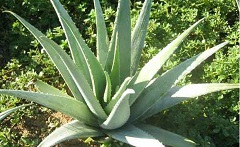
Aloe (Aloe vera) is widely used in folk medicine in different countries. It is believed that aloe has antibacterial, antiviral, antitumor, as well as immunoregulatory and hepatoprotective properties.
The main bioactive agent contained in the leaves of the plant is aloe-emodin, as well as acemannan, which blocks the replication of the virus.
In animal models, the combination of metformin (a potent anti-fibrotic agent) with aloe vera (a potent antioxidant agent) inhibited collagen accumulation, preventing fibrosis in the affected lung *. The doses used here, on a human scale, were 5'000 mg/day of metformin and the same amount of aloe leaf.
• Andrographis
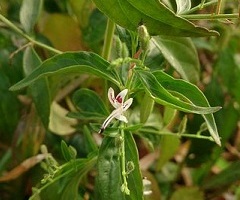
Andrographis (Andrographis paniculata) is widely used in traditional Chinese and Indian medicine to treat colds and flu. Andrographis has antibacterial, antiviral, immunomodulatory, anti-inflammatory, hepatoprotective, antithrombotic, hypoglycemic and hypotensive properties *.
Preclinical studies show that andrographolide, the main therapeutic component of andrographis, is active against 3CLpro and PdRp, and is able to inhibit the main protease as well as lopinavir *. Andrographolide also prevents the replication of many other viruses, in particular rhinovirus, by inhibiting the acidification of virus-containing endocytic vesicles, resulting in blocking of invasion and a dramatic suppression of RNA replication *. The content of andrographolide in a dry leaf is 0.4-3% by weight, on average about 2% *; thus 10 g of dry leaf contains approximately 200 mg of andrographolide (its daily dose).
The result of a 5-day clinical study comparing a group of patients who took 60 mg of pure andrographolide three times a day against a placebo group: the incidence of pneumonia during illness was 0% vs. 10.7%; nasopharyngeal detection of SARS-CoV-2 at day 5 was 34.5% compared to 57.1% *.
In another double-blind clinical trial, a mixture of andrographolide, curcumin, resveratrol, piperine, selenium, and zinc (ImmuActive™) reduced the duration and severity of Covid-19 disease in patients on the Modified Jackson Symptom Severity Scale * by more than a third. The number of days of hospitalization and the time it took to make a PCR test negative were lower in the manipulation group than in the placebo group. A meta-analysis of 33 randomized controlled trials found that andrographis extracts alleviated inflammatory symptoms and shortened the duration of cough, sore throat, and illness duration compared to standard treatment *.
The powder, extract, and even tablets of andrographis are very bitter, so it is usually taken in capsule form. The dosage is increased gradually, from 3×600 mg to 3×1'200 mg of herb powder per day, because in very rare cases, taking andrographis can cause hives and other undesirable effects.
The duration of taking andrographis should be limited only to the acute phase of a viral disease. Long-term use of andrographis, especially without justified reasons, including for prevention, is not recommended. It can exacerbate inflammation of the gallbladder and kidneys. In addition, it is a strong contraceptive and abortifacient.
• Marigold
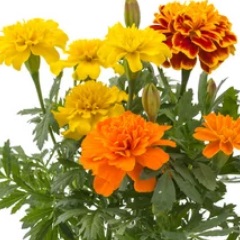
Marigolds (Tagetes erecta) are used in folk medicine in different countries as an antibacterial, antifungal, anthelmintic, antioxidant, antidiabetic, anti-inflammatory and analgesic agent. However, the antiviral activity of the plant prior to the emergence of SARS-CoV-2 was not reported.
In preclinical studies, quercetagenin, a natural flavonol from marigold flowers, showed high antiviral activity by inhibiting RdRp * * *, and was significantly superior to other natural inhibitors in the effectiveness of SARS-CoV-2 suppression *.
• Elderberry
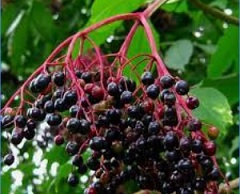
Elderberry (Sambucus nigra) is used in folk medicine as a diaphoretic, antipyretic and diuretic. In recent years, antibacterial, antiviral, antitumor and hypoglycemic properties have been restored.
Black Elderberry extract relieves the symptoms of SARS, including fever, headache, nasal congestion, and nasal discharge when taken within the first 48 hours of symptom onset * *. Most likely, this effect is caused by a large amount of polyphenols that are present in elderberry fruits, and not an antiviral protein, which folds during preparation of the syrup.
Elder Fruit Syrup (Sambucol™) taken 2 tbsp. on average per day, the incidence of seasonal influenza (A or B) the severity and duration of symptoms by an average of 1.3 days compared with the placebo group *. In a similar study (4×1 tbsp), symptoms resolved in an average of 4 days in the extract group compared to the placebo group *. At the same time, in a clinical study involving children 5 to 12 years of age who received 15 ml of elderberry juice (equivalent to 5.7 g of black elderberry fruit) internationally per day, there was no benefit *. Patients suffering from influenza improved their clinical condition by taking lozenges containing elderberry extract *.
Raw black elderberry fruit extract showed very strong activity in vitro against infectious bronchitis virus *. And there is reason to believe that it may be active against some other viruses *.
The therapeutic effect of elderberry syrup appears to be produced by the large amount of plant polyphenols and anthocyanins they contain. All parts of elderberry also contain lectins, including nigrin (PAPa, ribosome inactivating protein), which blocks protein synthesis in the cell *. During heat treatment and under the influence of alcohols, the protein undergoes denaturalization and loses its toxicity.
Thus, taking 1 gram of dry elderberry juice per day will be completely safe *. These should be ripe fruits collected in October, since the amount of cyanogens in them decreases during ripening.
• Ginkgo
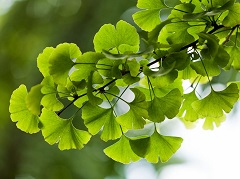
Ginkgo (Ginkgo biloba) is used in traditional Chinese medicine to relieve cough, phlegm, and fever from colds, as well as a number of other conditions. In modern medicine, ginkgo is commonly used in the treatment of early Alzheimer's disease, vascular dementia, and tinnitus of vascular origin.
The main component of ginkgo active against SARS-CoV is quercetin. Quercetin is one of the natural remedies that has undergone prospective, randomized, controlled clinical studies, with a high safety profile. A daily dose of at least 1'000 mg of quercetin has been administered for 30 days to outpatients in the early stages of Covid-19. The results showed a reduction in the frequency and duration of hospitalization, the need for non-invasive oxygen therapy, transfer to the intensive care unit, as well as a decrease in the number of deaths *.
Quercetin can affect various stages of entry as well as coronavirus replication players such as PLpro, 3CLpro, and nucleoside triphosphatase (ATPase)/helicase without exhibiting general toxicity *. Quercetin-rich onion skin extract was found to be a competitive ACE inhibitor comparable in efficacy to pure quercetin (IC50, respectively, 0.36 and 0.34 µg/mL) *. However, it will take about 2 kg of onion skins, to use ethanol to extract a therapeutic daily dose of quercetin (500 mg) from them *. The same dose of quercetin can be extracted from 100 grams of dry ginkgo leaf *.
The combination of ginkgo with acetylsalicylic acid enhances their antithrombotic effect *.
• Knotweed
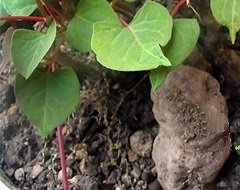
Knotweed (Reynoutria japonica, Fallopia japonica, Polygonum cuspidatum) is a popular traditional East Asian remedy for a wide range of ailments, including back pain, dizziness, liver disease, graying hair, and constipation. It exhibits neuroprotective, antioxidant, immunomodulatory, antihyperlipidemic, antithrombotic, antitumor, anti-inflammatory and antiviral properties *.
The part of the plant used is the roots and rhizomes.
The root of the plant contains emodin, which shows a high degree of inhibition of the SARS-CoV-2 virus by blocking the interaction of S-protein and ACE2 *. In addition to the mountaineer, the leaves of Aloe (Aloe vera) are also rich in emodin.
Highlander is especially rich in resveratrol, which also has a broad antiviral effect, as well as polydatin, a resveratrol precursor with anti-inflammatory and immunoregulatory effects. The average content of resveratrol in knotweed is about 1-3 mg/g *, which is significantly higher than that of its closest competitor, dark grapes.
Due to its antiplatelet effect, knotweed is not advised to be taken at the same time as blood-thinning medications, as it will potentiate their effects. In addition, its reception is stopped a week before any surgical manipulation.
Dosage: 0.5-1 teaspoon of root powder 3-6 times a day, or 10-30 g/day. To prepare the tincture, the powder is kept in 60% alcohol in a ratio of 1:5. To prepare an aqueous infusion, take 7 grams of raw materials per 1 liter of water, keep on low heat for 20 minutes, cool, filter and drink four equal doses throughout the day. The dose is increased gradually so that you can notice possible side effects in time and stop increasing it. The toxic dose of dry mountaineer root is about 75 g for a person weighing 75 kg; starting at this level, gastrointestinal disturbances and hepatotoxicity usually begin to be noticed.
• Mushrooms
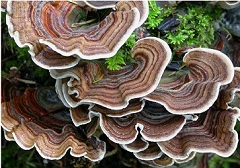
Medicinal mushrooms show antiviral, anti-inflammatory and immunomodulatory properties against various viruses such as HSV, hepatitis C virus, human immunodeficiency virus (HIV), influenza strain H1N1 and dengue virus * * *.
Commonly used mushrooms are the Turkey Tail (Coriolus versicolor), Chaga (Inonotus obliquus), as well as Ganoderma (Ganoderma lucidum) and Cordyceps (Cordyceps sinensis) shown here. They stimulate the production and activity of nonspecific immune cells (mainly NK cells and macrophages) *.
Most often, tinder fungi are used in the form of a ready-made extract or active substances (PSK – polysaccharide protein and PSP – polysaccharide peptide), because the process of extracting beta-glucan from the cell walls of the tinder fungus requires a special technology.
In Japan, Ganoderma extract is used in clinics for certain types of cancer to enhance phagocytosis.
• Ginger
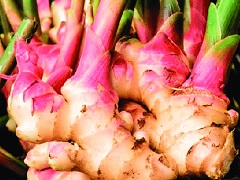
Ginger (Zingiber officinale) is widely used in traditional Chinese and Indian medicine and throughout the world to treat a wide range of different conditions, including arthritis, rheumatism, sprains, muscle pain, sore throat, cramps, constipation, indigestion, vomiting, hypertension, fever, infectious diseases and helminthiases. Ginger has strong antioxidant and anti-inflammatory properties, and not only prevents the risk of colds and flu, but also helps control their symptoms.
Ginger significantly reduces pulmonary fibrosis, oxidative stress and inflammation in animal models *. In mechanically ventilated (ventilated) patients with ARDS, as little as 120 mg of ginger extract per day reduced the incidence of pneumonia and the length of stay on a ventilator *.
• Chestnut
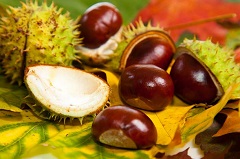
Chestnut fruits (Aesculus hippocastanum) are used in phytomedicine for the prevention and treatment of various diseases, such as venous congestion with leg ulcers, bruises, arthritis, rheumatism, diarrhea, phlebitis. Chestnut is effective in the short-term treatment of mild to moderate venous insufficiency *.
The main active ingredient is aescin, which dilates small blood vessels, facilitating blood flow. A growing body of evidence suggests that aescin has a strong anti-inflammatory, anti-edematous effect, and its use in clinics for the treatment of acute edema has been reported. Aescin exhibits antiviral activity against SARS-CoV, respiratory syncytial virus (RSV), and dengue virus. Aescin, given for 6-20 days, has been reported to be clinically effective in respiratory conditions (20 mg daily). In addition, the effect of aescin on acute pulmonary edema in patients with chest trauma, radiation pneumonitis, thoracotomy, and pneumonia has been reported. Finally, aescin improves lung function in patients with exacerbations of chronic obstructive pulmonary disease and chronic pulmonary heart disease by inhibiting cytokine release *.
Dosage – up to 1 g of fetus per day. Horse chestnut seed extract (Aescusan™) is available in pharmacies.
• Cinnamon
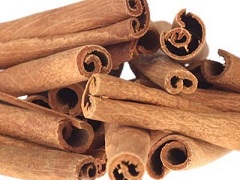
Cinnamon, the bark of the cinnamon tree (Cinnamomum cassia), is used in Indian Ayurvedic medicine as an antioxidant, anti-inflammatory, antidiabetic, antimicrobial, anticancer, antidiabetic and lipid-lowering agent * *.
The main biologically active compounds in cinnamon are cinnamaldehyde, eugenol and linalool. Taking cinnamon by mouth helps relieve sore throats in patients with SARS *
It is worth noting that Ceylon cinnamon is used for medical purposes, because. it contains the lowest coumarin content, which makes it possible to set a daily dosage of 3 grams. Other sources of cinnamon should not be used in excess of 1.5 grams per day.
• Turmeric
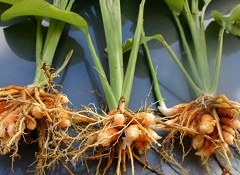
Turmeric (Curcuma longa) is widely used in Indian medicine for the treatment of a wide variety of pathological conditions due to its high antioxidant and anti-inflammatory properties.
Curcumin, the biologically active compound of turmeric, has antifibrotic, antioxidant, anti-inflammatory and immunomodulatory effects * * *.
Curcumin has a therapeutic effect in pulmonary fibrosis, severe respiratory diseases, lung infections and liver pathologies * * * *.
In addition, curcumin is a potent immune modulator and can regulate the function of dendritic cells, natural killer (NK), neutrophils, macrophages, T and B cells, and inflammatory cytokines *.
• Hoary rock-rose
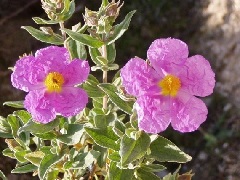
Hoary rock-rose (Cistus incanus) is a hybrid of two other species of cistus: Cistus albidus and Cistus crispus. Cistus are used as a remedy in traditional folk medicine in different countries. The crude extracts and essential oil of cistus are effective against inflammation, skin diseases, various microbial infections, diabetes, pain, arterial hypertension.
Cistus demonstrates antibacterial, antiviral, antifungal and antiparasitic effects. Its biochemical composition is rich in polyphenols, but all of them are still insufficiently studied. Cistus in vitro inhibited the activity of several types of viruses, including influenza, human immunodeficiency, dengue and ebola viruses *.
Cistus incanus herbal tea is available as well as a ready-made extract (Cystus052™).
• Pokeweed
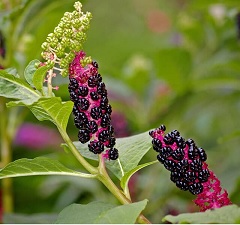
Pokeweed (Phytolacca americana). The main active ingredient of lakonos is an antiviral protein (PAP). It is a ribosome inactivating protein (RIP) that stops protein synthesis at the translocation step *. Typically, antiviral agents act specifically against one or a small number of viruses. But since protein synthesis is a common site for all viruses, RIP may prove to be a versatile antiviral strategy.
Widely distributed as a weed. In medicine, the root, leaves and fruits of the plant are used, which contain various forms of RIP. Doses of 1 g of dry root cause nausea and vomiting. Lower doses (60 to 100 mg/day of dried root and berries) are used in US Indian folk medicine to treat rheumatism and to stimulate the immune system. However, there are no clinical trials confirming the dosage and effectiveness of such treatment *.
• Red spider lily
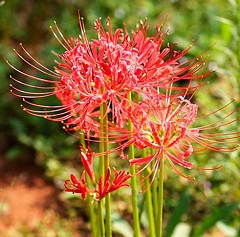
Licoris (Lycoris radiata) is rich in alkaloids and is used as an antiviral, anticancer *, antimalarial *, anti-inflammatory * and nausea * agent. Lycorine, also known as narcissin, is the main alkaloid of the bulbs and bark of the lycoris stem, enhances the secretion of bronchial glands, exhibits analgesic, antipyretic, anti-inflammatory properties.
In screening potential antiviral plants, lycorine surprisingly proved to be the most effective in vitro inhibitor of SARS-CoV replication identified *. It was 14 times more potent than artemisia, as well as other substances tested, including interferon-α, exhibiting potency comparable to or better than remdesivir *, while having low toxicity *. Lycorine blocks the processing of the viral polyprotein during translation, and blocks protein synthesis, inhibiting viral replication *. In addition, viral infection induces autophagy, which in turn supports viral replication, while lycorine suppresses autophagy *. Interestingly, in vitro lycorine was also highly effective against poliomyelitis, smallpox and herpes simplex (type I) * *.
Commercially, lycorine is not available in its pure form; however, lycoris bulbs are offered for seedlings. The content of lycorine in the bulb of a plant is 0.15% of its weight *. The average oral bioavailability of lycorine is about 40%.
Animal lethal dose toxicology estimates showed that the LD50 value of lycorine in mice was 112 mg/kg injected and 344 mg/kg orally (human eq 9 mg/kg and 28 mg/kg respectively). In assessing the antitumor activity of lycorine, it was administered to mice and rats at a dosage equivalent to 50-250 mg/day for humans * * *. The average dosage used in experiments with mice corresponds to 70 g/day of a human bulb. However, bearing in mind the high toxicity of the plant, the dose should be increased gradually, carefully monitoring the body's reaction.
However, these are all preliminary estimates. In fact, the therapeutic dose of lycorine is unknown, and no clinical trials have been conducted on its safety. To be honest, the calculations and grounds for the use of lycorine still look very shaky, and its use is extremely risky.
• Olive
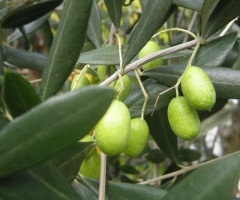
For therapeutic purposes, the leaf of the olive tree (Olea europaea) is used. Olive oil, rich in polyphenols, has been eaten for many centuries, but the medicinal properties of the tree leaf have only been noticed in recent years.
Daily intake of an ethanol extract equivalent to 20 g of an olive leaf and containing 100 mg of oleuropein reduced the duration of respiratory diseases in adolescents by a quarter due to the neutralization of enzymes necessary for the replication and spread of viruses *.
• Artemisia
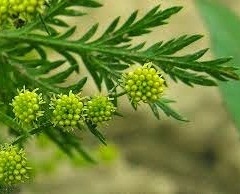
Artemisia (Artemisia annua) is an annual plant, otherwise called Sweet wormwood. Artemisia is used in traditional Chinese medicine to treat various febrile conditions, as well as an antimalarial, antiviral, and anticancer agent.
The main active ingredient in the aerial part of artemisia, which was discovered recently, is artemisinin. It has an inhibitory effect on parasites (eg Plasmodium, Toxoplasma gondii, Leishmania, Acanthamoeba, Schistosoma), viruses (eg hepatitis A virus, herpes simplex viruses 1 and 2, human immunodeficiency virus), fungi (Candida, Malassezia, Saccharomyces spp.) and bacteria (Enterococcus, Streptococcus, Staphylococcus, Bacillus, Listeria, Haemophilus, Escherichia, Pseudomonas, Klebsiella, Acinetobacter, Salmonella, Yersinia spp). Artemisia has also been reported to have anti-inflammatory and antitumor effects, and has been used to treat osteoarthritis, leukemia, renal cell cancer, non-small cell lung cancer, colon, breast, prostate, and liver cancer. In addition, artemisia is considered as an immunomodulatory plant.
Sufficient levels of iron are required for artemisinin to exert its activity. Reacting with iron, artemisinin produces large amounts of various forms of free radicals that destroy protein molecules, including lysosome membranes. The breakthrough of the aggressive content of lysosomes into the cytoplasm of the cell produces catastrophic destruction inside it, causing cell death *. Like predators, artemisinin primarily affects diseased, weakened and defective cells, including cancer cells.
Artemisinin showed high activity against the SARS-CoV-2 virus * * * * * *. Studies in China showed that artemisia alcoholic extract was the second most potent herbal remedy used in the treatment of the 2005 SARS-CoV outbreak * *. At the same time, artemisia extracts exhibit such low toxicity that they have been widely used to treat malaria even in newborns * *.
• Propolis
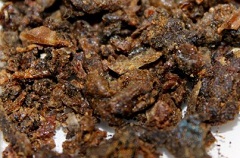
Propolis is a bee product obtained from the resins and exudates of plants. Used in folk medicine as an antibacterial, antifungal and antiviral agent.
Propolis phytochemicals that show activity against coronavirus include rutin, quercetin, myricetin, and caffeic acid phenethyl ester (CAPE) *. The rich polyphenol complex of propolis showed high binding to a variety of SARS-CoV-2 proteins, including 3CLpro, PLpro, RdRp, S-protein, helicase, and ACE2. Although propolis contains a relatively low concentration of bioactive substances (~ 5%) *, nevertheless, their rich diversity creates a pronounced synergistic antiviral effect. And the form of presentation (resins, oils and waxes) improves the bioavailability of polyphenols.
Propolis at 800 mg/day reduced the length of hospital stay for Covid-19 patients from an average of 12 days to 6 days and reduced the incidence of acute kidney injury by 4 times compared to controls *. Caffeic acid phenylethyl ester (CAPE), contained in propolis, reduced the severity of acute lung injury caused by the disease *.
Propolis has a protective effect on the heart *, liver *, kidneys *, pancreas *, lungs *, stomach * and other organs. In addition, propolis can increase antibody production after immunization * or vaccination * *, providing an earlier and longer protective period *.
Double-blind controlled studies show that propolis can significantly reduce hospital stay, as well as reduce the rate of acute kidney injury * *.
The dose of propolis 1'000 mg/day, equivalent to 60 drops of 10% propolis extract, diluted in about 100 ml of water, is taken 3-4 times a day. The oral dosage of propolis used in various clinical studies ranged from 0.8 g to 2.5 g per day.
In neutralizing SARS-CoV-2, propolis in liposomal form was in vitro as effective as remdesivir *.
• Rhubarb
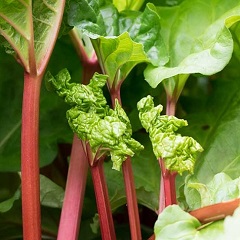
Rhubarb root (Rheum palmatum) has been used in China for over a thousand years to treat lung conditions due to its ability to mitigate inflammatory responses. It is also known as an antiviral, antipyretic, anticancer, antispasmodic, antibacterial, laxative, hemostatic, and antispasmodic *.
Emodin, one of its main active ingredients, improves acute lung disease by reducing the number of infiltrated inflammatory cells * *.
• Licorice
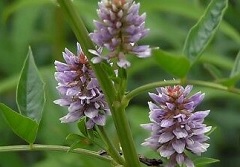
Ural licorice root (Glycyrrhiza uralensis) is widely used in China as an anti-inflammatory, antiviral, antibacterial, antioxidant, antitumor, immunomodulatory, and antitussive agent. Other countries use Licorice (Glycyrrhiza glabra) no less successfully.
The main active ingredient in licorice root, liquiritin, prevents lung damage and suppresses inflammation, thereby preventing pulmonary fibrosis *.
Glycyrrhizin, the other main ingredient that provides the sweet taste of licorice, has been shown to be effective against many other viruses and has already been used in their treatment * *. In animal studies, glycyrrhizin reduced the risk of death from co-infections with lethal doses of influenza virus *.
In addition to its direct effect on the virus, licorice boosts immunity by helping the body produce lymphocytes and macrophages * and increasing interferon levels *.
• Fish mint
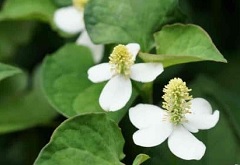
Houttuynia (Houttuynia cordata) is traditionally used in Chinese medicine to treat acute respiratory problems. It has anti-inflammatory, anti-allergic, antioxidant and anti-tumor properties *.
The leaves of this plant are rich in quercetin. Houttuynia was successfully used to treat patients during the SARS-CoV-1 outbreak *. They inhibit 3CLpro activity and interfere with RdRp activity, thereby blocking virus entry and hindering its replication. In addition, Houttuynia exhibits immunomodulatory properties *.
Hattuynia, just like green tea and dandelion root, does not exhibit cytotoxicity even in the highest concentrations *, making all these plants extremely safe to use.
• Black cumin
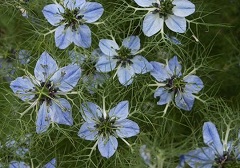
Other names are Kalinji and Nigella (Nigella sativa). Nigella seeds and oil are widely used throughout the world in the treatment of various diseases. It exhibits hypotensive, tonic, diuretic, antidiarrheal, antibacterial action.
The main bioactive agent in nigella seeds is thymoquinone. Nigella promotes an increase in macrophages and helper T cells, with a significant decrease in viral titer and elevated serum IFN-γ levels in humans and animals *. A multicenter classic double-blind clinical trial has confirmed the high efficacy of the combination of 1 g/kg/day of honey and 80 mg/kg/day of ground nigella seed in the treatment of patients with Covid-19 *. The deficiency of lymphocytes in patients was quickly eliminated with regular intake of a mixture of nigella, chamomile and natural honey *. The addition of nigella (900 mg/day) and vitamin D3 (2'000 IU/day) to standard treatment significantly accelerated negative PRC tests and improved symptoms in patients compared to the control group receiving standard treatment *. In another clinical study, patients with mild infections who were receiving standard treatment also received nigella oil (2×500 mg after meals). In the supplemented group, the number of people recovered within 14 days was 63% versus 35% in the control group *.
In addition, Nigella helps boost the immune response by improving the ratio of helper T cells (T4+) to suppressor T cells (T8+) * *.
• Garlic
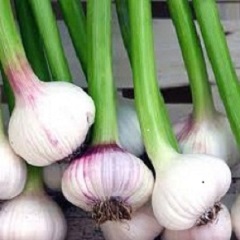
Garlic (Allium sativum) has a therapeutic effect against respiratory tract infections, intra-alveolar edema and cell infiltration, pulmonary fibrosis, sepsis and acute lung injury. It exhibits antibacterial, antifungal, anticarcinogenic, antioxidant, antidiabetic, antiatherosclerotic and antihypertensive effects.
The biologically active compounds of garlic, S-allylcysteine, alliin and allicin, have antiviral, antifibrotic, antioxidant, anti-inflammatory and immunomodulatory properties * * * * *.
Garlic is also a powerful immunomodulator *. In a clinical study, healthy individuals consuming 2 g of garlic with food every 2-3 days increased plasma levels of interferon-α, which is known to protect against viral infections and prevent viral replication *.
Fresh garlic is irritating, but aged or aged garlic does not lose its medicinal properties.
• Sage
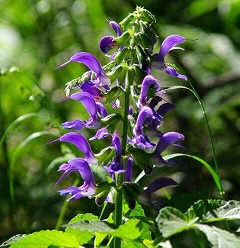
Sage root (Salvia miltiorrhiza) is an ingredient in many traditional Chinese medicine herbs and is used to treat a variety of ailments, especially heart and vascular conditions. It is used to eliminate blood stasis, improve blood circulation, against atherosclerosis, thrombosis, angina pectoris, and also as an antiviral agent that inhibits the activity of the RdRp enzyme.
Sage compounds inhibit polyprotein breakdown and viral replication, and reduce inflammation. Tanshinon IIA, one of the main active ingredients in sage, protected the lungs from damage by inhibiting levels of inflammatory factors as well as by stimulating macrophage migration *.
• Skullcap
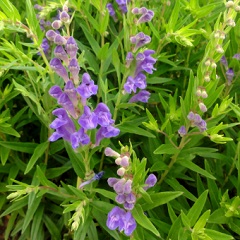
Baikal skullcap (Scutellaria baicalensis) is another popular herb in traditional Chinese medicine. Skullcap has a significant effect on the treatment of various diseases, especially hepatitis, diarrhea, vomiting and high blood pressure. Numerous components from skullcap root (baicalein, baicalin, luteolin, scutelarin, scutelarein) block the invasion of the virus into the cell, inhibit the cleavage of the polyprotein and the replication of the virus *. In addition, wogonin and baicalein reduce inflammation * and counteract blood thickening*.
Numerous components from the root of the skullcap (baicalein, baicalin, luteolin, scutelarin, scutelarein) block the invasion of the virus into the cell, inhibit the cleavage of the polyprotein and the replication of the virus *. In addition, wogonin and baicalein reduce inflammation and counteract blood thickening *.
• Essential oils
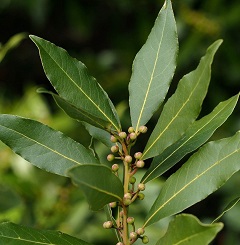
Essential oils are a complex mixture of aromatic volatile organic compounds. They have a wide spectrum of antibacterial, antifungal and antiviral activity. The main mechanism of their activity is damage to the lipid membrane of the pathogen, which leads to disruption of membrane transport, leakage of ions, and a decrease in the viability of the pathogen. In addition, at slightly higher concentrations, essential oils can also damage the membranes of cell organelles such as mitochondria, increasing oxidative stress and reducing cell energy, leading to their further death.
The antibacterial and antifungal effects of essential oils have been studied many times better than the antiviral effects *.
In preclinical studies, plant essential oils have shown antiviral effects against many viruses.
Florist's daisy (Chrysanthemum morifolium) seed oil and
Coco-grass (Cyperus rotundus) seed oil were active against herpes viruses (HSV-1) and hepatitis A, as well as vesicular stomatitis (VSV) and Coxsackie B4 * *.
Tea tree (Melaleuca alternifolia) essential oil has shown a strong protective effect against HIV *.
Other polyphenols in the oils exhibit antiviral activity against a wide range of other viruses (hepatitis B and C virus, HIV, influenza A virus, dengue virus, respiratory syncytial virus, Newcastle disease virus, foot-and-mouth disease virus and enterovirus) *.
Cinnamon (Cinnamomum zeylanicum), Pelargonium (Pelargonium graveolens), Sage (Salvia officinalis), Thyme (Thymus vulgaris), and Lemongrass (Cymbopogon flexuosus) oils showed strong inhibitory effects against the H1N1 virus. However, the action of each of the essential oils is not universal, and is specific to a particular virus.
Essential oils from Laurel (Laurus nobilis) leaf and Oriental thuja (Thuja orientalis) leaf in vitro inhibited SARS-CoV replication with IC50 of 120 and 130 µg/mL, respectively *. Since bay oil is familiar to our body, at least it should not cause a negative reaction. Essential oils from many other sources, such as Black cumin (Nigella sativa), Bergamot (Citrus bergamia), and citrus peels, also show high activity against SARS-CoV. All of them can be allowed for use not only because of their antiviral effect, but also on the basis that most of the bioactive substances we have considered are more soluble in fats than in water.
Basil (Ocimum sanctum) oil, after 4 weeks of supplementation, significantly increased levels of IFN-γ, IL-4, T-helper cells and NK cells in healthy individuals *.
Essential oil blends work synergistically. For example, a mixture of essential oils from dry leaves of Thymus (Thymus capitatus), Sage (Salvia fruticosa) and Oregano (Origanum dictamnus), enhancing each other's actions, significantly inhibit influenza A and B viruses, as well as human rhinovirus *.
Aromatherapy is a well-known way to use essential oils for respiratory infections. When inhaled, essential oils are able to penetrate the smallest spaces in the lungs and stay there for long periods of time. About 5% of inhaled oils penetrate the brain, the rest are absorbed into the bloodstream, after which, after passing through the liver, they are excreted by the kidneys. Being in the alveoli of the lungs, essential oils reduce inflammation and reduce swelling.
The most powerful anti-inflammatory effect when applied topically is (in descending order) oils of Clove (Syzygium aromaticum), Coriander (Coriandrum sativum), Black Pepper (Piper nigrum) and Clary Sage (Salvia sclarea) *. Any of these oils available can be used for aromatherapy in SARS patients.
Interestingly, the vast majority of essential oils also exhibit antihistamine activity, especially (in descending order) Lemongrass (Cymbopogon citratus), Sandalwood (Santalum album), Lemon (Citrus limon), Carrot (Daucus carota) *.
• Echinacea

Echinacea purpurea (Echinacea purpurea) is a well-known immunostimulant and adaptogen.
In preclinical studies, echinacea has shown a high degree of binding to 3CLpro *.
Echinacea, as a commercial extract of Echinaforce™, has shown in vitro dose-dependent inhibition of viral infectivity in respiratory epithelial cells. This extract irreversibly inactivated the SARS-CoV-2 virus with an IC50 of 3.2 µg/mL *. Similarly, inhibition of MERS-CoV was observed in vitro with 10 µg/ml Echinaforce™, with a 99.9% reduction in viral infectivity *.
Echinacoside contained in Echinacea angustifolia shows very high binding to the SARS-CoV-2 RdRP *, but Echinacea purpurea contains extremely low echinacoside content.
Combining echinacea with vitamin D, vitamin C, and zinc is thought to reduce the risk of infection and death from SARS-CoV-2 *, as well as reduce the duration and/or severity of SARS symptoms *.
However, it is worth remembering that the immunomodulatory ability of echinacea falls very quickly, and it is not recommended to take it for more than one to two weeks.
• Knotgrass
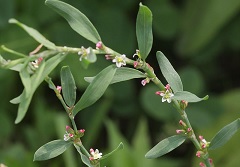
Knotweed (Polygonum aviculare) contains a rich composition of flavones such as kaempferol, myricetin, luteolin and quercetin, extracted from its aerial parts with ethanol or butanol *. Thanks to quercetin, knotweed is a strong antioxidant, anti-inflammatory *, antibacterial and antiviral * * agent.
In an open-label clinical trial of 60 severely ill patients, the control group received conventional antivirals such as remdesivir or favipiravir, while the intervention group received an additional 1'000 mg/day of quercetin over a 7-day period. Quercetin supplementation was significantly associated with earlier discharge and decreased serum levels of inflammatory markers *.
Knotweed helps increase blood clotting. Thanks to this, it may be able to balance the presence of blood-thinning drugs such as ginkgo, sage and skullcap in the herbal collection.
Kaempferol, quercetin and myricetin have the ability to inhibit helicase, myricetin is able to inhibit 3CLpro, and quercetin is able to inhibit viral replication in vitro. Computer modeling revealed that the plant components of knotweed - quercetin, luteolin, kaempferol and naringenin - interact with the largest number of Covid-19 therapeutic targets *. This makes knotweed a very attractive candidate.
• Others
Tinospora (Tinospora Cordifolia) may help reduce fever in Covid-19 patients and relieve breathing problems *. Tinospora has been shown to be effective in eliminating nasopharyngeal carriage of the virus in Covid-19 patients within 5 days of use * *.
Senna (Cassia angustifolia) contains the glycoside sennoside in its leaves and pods, which in molecular dynamics simulations showed the strongest binding to RdRP compared to all other substances studied *. Even remdesivir and ritonavir had one and a half times lower binding energies *. Other substances that performed at or better than remdesivir were digoxin from Foxglove (Digitalis purpurea), asiaticoside from Asiatic pennywort (Centella asiatica), glycyrrhizin from Licorice (Glycyrrhiza glabra), aloin from Aloe (Aloe vera), and quercetin from Japanese pagoda tree (Sophora japonica) *.
Alcoholic extracts of Chinese goldthread rhizome (Coptis chinensis), Black cohosh rhizome (Cimicifuga racemosa), Sophora root (Cimicifuga racemosa, as well as Sophora flavescens), Japanese hedge parsley berries (Torilis japonica) and Eleutherococcus bark (Acanthopanax gracilistylus) were reduced in vitro virus replication was stronger than the control drug ribavirin, while their cytotoxicity was many times lower * *. Presumably, this effect was due to a decrease in viral RNA expression by inhibition of RdRp. Potential active ingredients here could be, respectively, berberine, ferulic acid, matrine end sophoradin, torilin, and acanthosides.
Despite the antiviral effect of extracts of these plants or their components, discovered in laboratory conditions, reports of their clinical studies could not be found.
As with other complex diseases, betting on monotherapy is likely to be ineffective. An integrated approach looks more attractive, in which the virus receives counteraction on the entire front of hostilities.
Namely:
1) preventing the virus from entering the body (antiviral nasal spray);
2) preventing the entry of the virus into the cell (virus inactivation, blocking the invasion, immune destruction);
3) suppression of virus replication (control of intracellular calcium, changes in the acidity of the cytoplasm, inhibition of replication enzymes);
4) decrease in the inflammatory index (TNF-β, IL-1β, CRP);
5) immune modulation (activation of B- and T-cells).
Spray
As a routine prophylactic agent that provides antiviral protection of the nasal mucosa, you can use a nasal spray of the following composition:
• Sodium bicarbonate, solution for infusion, 8.4% (as a base) – 6 ml; alternative: water – 6 ml with the addition of kitchen salt – 0.1 g for isotonic solution * *;
• Glycerin (for viscosity and virus capture) – 50 drops;
• Aloe juice (to block virus docking) – 20 drops;
• Shampoo Johnson's baby™ (surfactant to dissolve the lipid membrane of the virus) – 2 drops * * *;
• Lugol's solution (to inactivate the virus) – 2 drops *;
alternatives: onion pulp – 10 drops *, eucalyptus oil – 1 drop *,
propolis – 10 drops *;
• Colloidal silver (as a preservative) – 5 drops *.
Pour into an empty nasal spray bottle. Irrigate the nose as dryness is lost; usually 6 times a day, 2 sprays in each nostril. Store in the refrigerator for up to two weeks. The list is compiled based on sprays already in use and the results of clinical studies.
The market offers ready-made nasal sprays such as Viraldine™, CofixRx™, VirX™. At the same time, the FDA does not recommend formulations that can disrupt the natural bacterial balance of the nasal and sinus mucosa. In addition, the FDA warns against the abuse of iodine compounds, which can increase thyroid hormone concentrations *. Patients who fear such consequences can exclude iodine and silver from the proposed composition, however, the shelf life of the spray may be reduced.
A randomized clinical trial found that elderly outpatients who tested positive for SARS-CoV-2 and immediately initiated nasal irrigation with a solution containing povidone-iodine (or with an alkaline isotonic) after diagnosis had an eight times lower risk of hospitalization than national figures (1.27% vs. 10.6%) *. In high virus concentration settings, such as when visiting or caring for patients, nasal interferon-α is recommended for prophylaxis.
Preventive Supplements
The following proven agents are offered as routine antiviral prophylaxis:
• Vitamin D3: up to 3'000 IU/day, target blood 25(OH)D is 75-125 nM/l (30-50 ng/ml) *;
• Vitamin C: 2×500 mg, target plasma vitamin C level of at least 12 mg/l *;
• Elemental zinc: 30-100 mg/day, target plasma zinc level 120 μg/dl *;
• Quercetin – 2×150 mg or knotweed root 2×1'000 mg *;
• Melatonin at bedtime – from 0.5 mg/day, but not more than 10 mg/day *;
• Vitamin B3 (nicotinamide) – 500 mg/day *;
• Aspirin – 150 mg/day;
• Neem (standardized extract) – 50 mg/day *.
The list is based on the recommendations of Dr. Vladimir Zelenko*.
Preventive herbal collection
Designed for people at high risk of infection:
• Eleutherococcus (Eleutherococcus senticosus) : 2 parts,
• Astragalus (Astragalus) – 2 parts,
• Cordyceps (Cordyceps militaris) – 1 part,
• Rhodiola (Rhodiola rosea) – 1 part,
• Licorice (Glycyrrhiza uralensis) – 1 part.
Dosage of the immunomodulatory collection: 1 teaspoon of extract 3 times a day.
• Mango (Mangifera indica), seeds; standardized to 60% mangiferin as a general anti-inflammatory agent. Dosage: 1-3 capsules 3 times a day.
• Lumbrokinase or nattokinase – for blood thinning: 1 capsule in the morning and 1 capsule in the evening.
• L-malic acid: 600 mg/day.
The list is based on recommendations from Stephen Harrod Buhner*.
The main protocol for the treatment of acute respiratory coronavirus infection
In the absence of prescribed treatment, you can adhere to the following list. Otherwise, the points listed below should be agreed with the attending physician. The list is based on the protocol of Dr. Paul Marik*.
• Vitamin A (retinol palmitate) as a booster of innate immunity – 30 mg (100'000 IU).
• Vitamin C as a strong antioxidant – 4×1'000 mg on the first day of symptoms followed by 4×500 mg of calcium ascorbate (Ester-C™).
• Vitamin E as a cooperator of vitamin C – 4×10 mg.
• Vitamin D3 as a regulator of immune functions – 100'000 IU once *, followed by 1×10'000 IU * * *.
• Zinc elemental as an inhibitor of viral RNA polymerase – 6×30 mg in the first three days of illness, then 6×15 mg * *.
• Selenium as a coactivator of immune cells – garlic powder 15 g, Brazil nuts – 3 pcs. Zinc and selenium levels are important both in preventing disease and in reducing the risk of death *.
• Hydroxychloroquine (Plaquenil™) as an enhancer of zinc transport into cells – 600 mg/day *.
• Bromhexine as a bronchodilator and serine proteinase inhibitor (TMPRSS2) – 3×32 mg * *.
• Amantadine as a viroporin inhibitor (specific for SARS-CoV) – 100-200 mg *.
• Iodines as a coactivator of immune cells – 1×5 mg (1 drop of Lugol's solution).
• Acetylsalicylic acid to increase blood flow and prevent blood vessel thrombosis – 4×100-250 mg (only if other antithrombotic drugs are not taken).
• Serrapeptase is a mucolytic with a wide range of therapeutic effects, including anti-inflammatory, antimicrobial, antithrombotic and fibrinolytic (3×10 mg between meals).
• Melatonin as an activator of helper T-cells – 3 mg at night *.
• DHEA (dehydroepiandrostenedione) at the beginning of the day as a cytokine inhibitor – 200-400 mg (only in case of a strong cytokine reaction).
• Potassium to reduce acid stress and reduce the risk of thrombosis – 30 g (2×1 tbsp) potassium bicarbonate (KHCO3).
• Inhalations (eucalyptus oil).
Compare with the recommendations developed by the Ministry of Health of Ukraine in 2021:
Preventie:
• Vitamin C – 2×500 mg and quercetin – 250 mg/day.
• Vitamin D3 – 1'000-4'000 IU/day.
• Complex of B vitamins.
• Zinc – 30-50 mg/day.
• Melatonin (slow release) – start at 0.3 mg and increase if well tolerated to 2-3 mg at night.
• Ivermectin for post-exposure prophylaxis 200 μg/kg immediately, then repeat on day 3; for prophylaxis in high-risk groups, 200 μg/kg on the first day, then on the third day, and then every 4 weeks).
Patients with mild symptoms staying at home:
• Ivermectin – 2×150-200 μg/kg.
• Vitamin C – 2×500 mg and quercetin 2x500 mg.
• Vitamin D3 – 2'000-4'000 IU/day.
• Complex of B vitamins.
• Zinc – 75-100 mg/day.
• Melatonin – 6-10 mg at night (the optimal dose is unknown).
• Acetylsalicylic acid (aspirin) – 81-325 mg/day (in the absence of contraindications).
In symptomatic patients, blood oxygen monitoring with a pulse oximeter is recommended. Outpatient desaturation below 94% requires hospitalization.
Patients with mild symptoms (lying):
• Ivermectin – 2×150-200 μg/kg.
• Vitamin C 500 mg orally every 6 hours and quercetin 2×250-500 mg.
• Vitamin D3 – 20'000-60'000 IU single oral dose. An alternative is calcifediol 200-500 μg. Then 20'000 IU weekly until discharge from the hospital.
• Complex of B vitamins.
• Zinc – 75-100 mg/day.
• Melatonin – 10 mg at night (the optimal dose is unknown).
• Enoxaparin – 60 mg/day.
Herbal antiviral collection
As can be seen from the overview above, we have a rich, evidence-based selection of plant materials to formulate a collection against SARS-CoV-2 and, in general, against other coronaviruses. It is assumed that the combination of several bioactive components will deactivate a greater number of virus binding sites with receptors; suppress several critical points of virus replication; reduce symptoms of inflammation and damage to lung tissue; modulate the body's immune response *.
When compiling a herbal collection, it is necessary to take into account not only the effectiveness of the active substances, but also their concentration in the plant source, as well as the availability and price of the latter. The table below represents the result of this compromise.
Common name |
Latin Name |
Part plants |
Active substance |
Daily dose |
Solvent |
underground |
glycyrrhizin |
water |
|||
flower buds |
eugenol |
powder 1 g |
water, ethanol |
||
- |
polyphenols |
water, ethanol |
|||
underground |
tanshinones |
ethanol |
|||
underground |
baicalein |
5:1 extract 1 g * |
acetone, ethanol |
||
bark |
cinnamaldehyde |
powder 3 g * |
water, ethanol |
||
fruits |
polyphenols |
water |
|||
aerial |
andrographolide |
10:1 extract 1 g * |
ethanol |
||
leaf |
artemisinin |
dichloromethane |
|||
aerial |
carvacrol |
ethanol |
|||
Knotgrass |
Polygonum aviculare | aerial |
myricetin |
ethanol |
|
seeds |
glucoraphanin |
powder 5-15 g * |
ethanol |
||
Black pepper |
seeds |
piperine |
powder 0.5 g |
ethanol |
All these components are available in online trading, just like gelatin capsules and a machine for sealing them. Thus, there are no problems for making the mixture yourself. Elderberry syrup is taken separately.
Here the dosage is indicated for the use of each of the components by itself. But since they will work together, the daily dose of the entire combination can be reduced to 6-12 g, depending on the severity of the disease. Syrup with elderberry, knotweed, nigella and broccoli is taken separately.
Due to the successful combination of components, the proposed composition should be effective at all stages of the coronavirus life cycle:
Common name |
Clutch | Fusion | Translation NSP | Protein synthesis and assembly | Maturation and release | ||||||||
S-protein |
ACE2 |
TMPRSS2 |
cathepsin |
3CLpro |
PLpro |
NRF2 | RDRP |
N-protein |
helicase |
NSP | 3a-protein |
lysosome | |
Liquorice |
|||||||||||||
Clove |
|||||||||||||
Propolis |
|||||||||||||
Sage |
|||||||||||||
Baikal skullcap |
|||||||||||||
Cinnamon |
|||||||||||||
Elderberry |
|||||||||||||
Creat |
|||||||||||||
Sweet wormwood |
|||||||||||||
Oregano |
|||||||||||||
Knotgrass |
|||||||||||||
Broccoli |
|||||||||||||
Black cumin |
|||||||||||||
The above table allows you to evaluate which stage of the virus life cycle each component affects and what the removal of one or another position will lead to. It is noticeable that the central components of the collection are skullcap, artemisia, propolis, licorice and knotweed.
Such a composition has not only antiviral, but also many other useful side effects:
Common name |
Actions |
|||||||||||
Viruses |
Oxidation |
Inflammation |
Fibrosis |
Thrombosis |
Pain |
Lymph |
Immunity |
Bacteries |
Fungi |
Parasites |
Tumor |
|
Liquorice |
||||||||||||
Clove |
||||||||||||
Propolis |
||||||||||||
Sage |
||||||||||||
Baikal skullcap |
||||||||||||
Cinnamon |
||||||||||||
Elderberry |
||||||||||||
Creat |
||||||||||||
Sweet wormwood |
||||||||||||
Oregano |
||||||||||||
Knotgrass |
||||||||||||
The color indicates the expressiveness of this or that effect, from dark green (strong positive effect) to light green (weak positive effect). An expressively negative effect is highlighted in orange.
Moreover, it can be useful not only for coronavirus, but also for many other viral diseases:
Common name |
Proven in vitro activity against various virus families |
||||||||||||
Orthomixo |
Corona |
Paramixo |
Filo |
Retro |
Picorna |
||||||||
fluA HxNx |
corona COV |
parainfl. PIV |
resp-s. RSV |
measles MEV |
newcastle NDV |
ebola EBOV |
marburg MARV |
AIDS HIV1 |
entero EV71 |
hepatitisB HBV |
coxsackie CV |
polio POV |
|
Knotgrass |
|||||||||||||
Red to yellow here represent viruses that are subjectively rated high to moderate in their chances of creating a future epidemic.
The unfavorable compatibility of the components of the mixture is unknown:
Name |
# |
1 |
2 |
3 |
4 |
5 |
6 |
7 |
8 |
9 |
10 |
Action |
Liquorice ! |
1 |
! |
! |
Changes the viscosity of the virus envelope. Stimulates the production of NO and β-IF. |
||||||||
Clove |
2 |
Destroys the shell of the virus. Suppresses the process of virus replication. * |
||||||||||
Propolis |
3 |
Complicates docking and invasion of the virus, suppresses replication. |
||||||||||
Sage |
4 |
! |
! |
Reduces the expression and transcription of the N-protein gene, improves immunity. |
||||||||
Baikal skullcap |
5 |
! |
! |
Inhibits replication by reducing protease activity. |
||||||||
Cinnamon |
6 |
Inhibits viral protein synthesis at the level of post-transcription. |
||||||||||
Elderberry |
7 | Inhibits the synthesis of any protein within the cell | ||||||||||
Creat ! |
8 |
Inhibits the processes of docking, invasion and replication of viral RNA. |
||||||||||
Sweet wormwood ! |
9 |
Breaks down proteins within the cell. Inhibits the formation of the virus. |
||||||||||
Oregano |
10 |
Blocks docking, fusion, replication and release of the virus. |
Internet resource Drugs.Com reports the interaction of some of these substances:
The interaction is minimally clinically significant. Minimize risk.
There is no interaction information.
However, it is worth paying attention to the combination of the mixture with other drugs taken. Ginkgo biloba and horse chestnut promote blood thinning and, when combined with anticoagulants commonly prescribed for Covid-19, could theoretically pose a risk of increased bleeding. Sage and pelargonium also have a similar, but even weaker effect. In addition, according to the canons of Chinese medicine, the use of sage, andrographis and elderberry is not allowed during pregnancy.
Some antiviral plants have a narrow therapeutic corridor, that is the difference between the therapeutic and cytotoxic dose is not very large. This means that they should be handled with care. These include, for example, Chrysanthemum (Chrysanthemum moliforium), Artemisia (Artemisia annua), Woundwort (Prunella vulgaris), Perilla (Perilla frutescens), Catnip (Nepeta tenuifolia), Wild mint (Mentha haplocalyx).
Others do not seem to show cytotoxicity even at extremely high doses, such as Ganoderma (Ganoderma lucidum), Fish mint (Houttuynia cordata), Dandelion (Taraxacum mongolicum), Green tea (Camelia sinensis), Coltsfoot (Tussilago farfara), Longan (Dimocarpus longan) *.
The technology of preparation from coarse raw materials and the dosage of this herbal remedy are as follows:
Preparation of extract . All dry raw materials in the appropriate amount are ground into powder. The mixture is poured into a water-alcohol solution (50:50) and pre-soaked for 2 hours. The ratio of the mass of liquid to the mass of raw materials should be 9:1. Then the resulting mass is treated for 3 hours with ultrasound with a specific power of 5 watts/dm2. Instead of sonication, the mixture can be infused for 7 days in a dark place at room temperature. Then the resulting mass is kept on low heat (75 °C) with the lid open until the volume of the liquid is reduced by a factor of three. The dishes are removed from the heat, allowed to cool to room temperature and filtered. A solution of propolis is added to the finished broth, closed in a dark glass container and stored in the refrigerator. Store no more than 6 days. For taste, you can add honey and any spices from the list above.
Reception: 3 times a day for 40-50 ml. It is used only during treatment (up to 2 weeks, but not more than 3 weeks). Since some people may have an individual reaction to some components, it is recommended to increase the dose gradually, monitoring your condition.
The dosage indicated in the table is intended for monotherapy with each of the components. The combination of several means will most likely have a summing or even synergistic effect. Each chemical has its own concentration range, which exhibits a therapeutic effect. Going beyond it can nullify the desired result, or even become counterproductive. Thus, the indicated dosage can actually be reduced. Unfortunately, we cannot predict exactly how much. The only criterion for evaluation is our well-being.
Preparation of syrup. The fruits of black elderberries (200 g), pig grass leaves (150 g), nigella seeds (50 g) and broccoli seeds (150 g) are finely ground and mixed with honey (500 g).
Reception: 3 times a day, 1 tablespoon, in addition to the extract.
Preparation of a solution from whole raw materials allows you to get a composition that is extremely rich in bioactive substances. On the other hand, the disadvantage of self-preparation of herbal infusion is the inability to control the required concentration in the solution of active ingredients. The reason is that the biochemical composition of any plant depends on many factors, such as the place and time of collection, weather conditions, soil composition, etc. In addition, this process is troublesome, and the cooked product will certainly have an unpleasant taste, while packaging extracts in capsules avoids both the first and second.
Therefore, the table presents ready-made normalized preparations in the form of plant extracts, and not in the form of raw materials, which would need to be several times larger in volume. In the case of using extracts, there is no need to prepare an infusion, and the remaining items (cinnamon, cloves, peppers and broccoli) can either be sealed in gelatin capsules or taken as a food seasoning.
The principal drawback of the proposed composition remains that the antiviral effects of most of its components have been demonstrated, for the most part, in cellular models, and it has not yet been firmly proven that they will be the same in the natural conditions of the body. However, the composition of the proposed formula closely resonates with other Chinese medicine antiviral medicinal preparations *. Some of them have been clinically tested in clinics in mainland China and have shown remarkable results in reducing symptoms and reducing recovery time. Therefore, we can cautiously assume that this collection will be no less effective.
Each of the components of the proposed formula has been shown to be effective, and there are reasonable grounds to believe that their combination will be more effective than either of them on its own. A study of the 10 most popular traditional herbs in China showed that any of them, at the appropriate dosage, has an effectiveness comparable to the well-known antiviral drug oseltamivir *. It is known that about half of the drugs currently in use are modified molecules of plant origin. This gives hope that herbal formulas can be quite effective.
Thus, the traditional anti-cold preparations QingFei PaiDu Tang™, LianHua QingWen™, Gan Lu Xiao Du™, in clinical studies showed a noticeable reduction in symptoms in most patients with Covid-19, and stabilization of the condition after the start of their intake in the rest * *. Other recommended Chinese formulas include MaXing ShiGan Tang™, HuoXiang ZhengQi™, JinHua QingGan™ * and ShuFeng JieDu™ *. It was officially reported that in China, approximately 85% of all Covid-19 patients were treated with traditional Chinese medicine * *.
However, there are very few clinical studies of such herbal preparations. The reasons for this are obvious. Any of the components of the plant complex is a natural substance, which means that it cannot be patented. There is hardly a madman who is ready to spend billions of dollars without the hope of making a profit. And public funds, as we see, prefer to be spent on other needs. Therefore, there are so many dubious vaccines, and so few natural treatment protocols.
Increasing the bioavailability of agents
A serious problem affecting the effectiveness of therapeutic agents taken orally is their rapid metabolization and excretion from the body. This is largely due to the fact that after being absorbed in the intestines and entering the blood, they immediately pass through the liver. This problem can be solved to some extent by alternative routes of administration, for example, nasal or rectal. Both of them have their drawbacks and limitations, and seem less convenient and attractive than the usual oral intake. The easiest way to maintain a sufficient concentration of active substances in the body is to take them more often.
Another problem is the poor water solubility of most of the proposed bioactive substances, which impairs their bioavailability and requires an increased dosage. Black pepper (Piper nigrum), due to its piperine content, is able to increase the bioavailability of many drugs and phytochemicals by increasing their absorption from the gastrointestinal tract *. For example, taking black pepper along with turmeric in a ratio of 1:100 can increase the bioavailability of the latter by up to 2'000 times *. However, it is not known how much piperine can enhance the bioavailability of the remaining active substances of our complex.
An alternative way to get around this problem is to use nanocarriers. Consider two options: 1) packaging of molecules in cyclodextrin, and 2) packaging in liposomes. Both methods require the extraction of the active substances with alcohol, so the preparation of the solution must in this case be carried out without water. Those. the ratio of the dry mixture to alcohol should be 9:1; and after extraction, the liquid is evaporated by volume by 3 times and thoroughly filtered.

Cyclodextrin is a dietary carbohydrate approximately 70 nm in size with a molecular structure in the form of a cone, inside which other, smaller molecules can enter and be retained. Nanoparticles of this size are not perceived by the cells of the reticuloid endothelial system and, therefore, avoid rapid filtration by the liver and spleen *. Cyclodextrin has a lipophilic central cavity and a hydrophilic outer surface. The lipophilic inner side of cyclodextrin binds well to fat-soluble molecules, i.e. with the vast majority of the substances discussed above. «Escape» from water, hydrophobic molecules take refuge in the interior of the cyclodextrin molecular cup.
Loading cyclodextrin with content is very simple. Beta-cyclodextrin (1'600 mg) is dissolved in 320 ml of hot deionized water in a glass container. After cooling, add 1'600 ml of a 30% pre-prepared alcohol solution of the active substances. The resulting mixture was stirred at room temperature for several hours with a stirrer at 400 rpm until all the alcohol had evaporated. Store in the dark at 4 °C for several days *. Take 1 tsp. three times a day.
Beta-cyclodextrin is inexpensive and readily available, and easy to work with at home. For all their advantages, cyclodextrins are not closed containers, and can lose their contents just as quickly. Thus, they do not remove the problem of rapid cleansing of the body from active therapeutic substances.
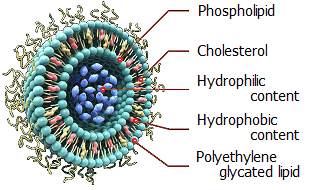
Liposomes are spheres formed by a double lipid layer similar to a cell membrane. They allow the transport of both hydrophilic substances (in the inner compartment) and hydrophobic ones (between their two layers). The figure below shows a cross-section of a liposome sphere.
Liposomes release their contents more slowly than cyclodextrin, which makes it possible to maintain a more uniform blood concentration of the bioactive substances loaded in them. However, liposome technology produces relatively large particles (> 200 nm) and particle size and stability are highly dependent on the specific fatty acids used. Loading liposomes is technologically much more difficult than loading cyclodextrin; this requires separately preparing two parts – lipid and water.
To prepare the lipid part, 3.2 g of stearic acid and 1.6 g of lecithin are dissolved in 160 ml of the previously prepared alcohol extract using ultrasound. To prepare the aqueous portion, 3.2 g of polyethylene glycol monostearate is dissolved in 480 ml of deionized water. Both parts are heated to 75 °C.
The molten lipid portion is then added through a G23 injection needle (diameter 0.6 mm) to the hot aqueous portion, stirring at 1'000 rpm. In this case, the organic solvent migrates into the aqueous part, causing the precipitation of nanoparticles. Stirring is continued for approximately 1 hour at 75 °C. During this treatment, the organic solvent is completely evaporated and the volume of the mixture is concentrated to approximately 5 ml.
After that, the resulting composition is immediately placed in an ice bath (0-2 °C), and 5 ml of cold water are added, stirring at a speed of 1'200 rpm for 2 hours * *. After cooling, store in the refrigerator for no more than 2 weeks. Take 1 tsp. three times a day.
Both of the proposed packaging methods for nanodelivery of active substances make it possible to reduce the dosage by several times. However, we cannot determine exactly how many times exactly, which means that there is uncertainty in the amount of active substances that have entered the body.
Other additives
Since the coronavirus S-protein causes erythrocyte aggregation (clumping), which slows blood flow, impairs oxygen supply, raises blood pressure and increases the risk of thrombosis, it is worth considering the use of B vitamins.
Niacin (B3), folic acid (B9), methylcobalamin (B12) reduce homocysteine levels and general inflammation * *. Vitamin B3 dilates small blood vessels, improving blood microcirculation. This prevents damage to tissue, including the lung epithelium. The dosage for healthy people is approximately 20 mg/day. Vitamin B3 may come in sufficient quantities from other sources, so its dosage is not precisely determined. An overdose of B vitamins does not lead to negative results. However, care must be taken when combined with antihypertensive drugs, anticoagulants and acetylsalicylic acid.
Given that elderly patients are most likely to become severely ill with Covid-19, they should also consider supplementation, which is usually required for people in this age group:
• Coenzyme Q10 and succinic acid are two agents to support mitochondrial function. Dosage – 200 mg every morning.
• N-acetylcysteine (NAC) – to increase the level of intracellular antioxidant – glutathione. Dosage: 600 mg/day.
• Metformin is a natural ingredient from goat's rue (Galega officinalis). Reduces blood glucose levels and tissue oxygen demand *. Dosage – 500 mg/day, during the day and in the afternoon.
Patients are usually advised to drink plenty of warm water. In various clinical studies, herbal infusions of the following plants have shown positive results in reducing the inflammatory state when severe symptoms appear * * *:
• Licorice (Glycyrrhiza glabra), root;
• Chinese angelica (Angelica sinensis), root;
• Common ginseng (Panax ginseng), root; alternative – echinacea (Echinacea purpurea), root; astragalus (Astragalus membranaceus), root;
• Chinese sage (Salvia miltiorrhiza), root;
• Red clover (Trifolium pratense), flowers;
• Peppermint (Mentha piperita), leaf; alternative – amaranth (Amaranthus tricolor), leaf.
A mixture of available plants, taken in an equal weight part, is poured with boiling water in a ratio of 1:10 and infused in a thermos for 45-60 minutes. Cinnamon and black pepper, cranberries or lemon are added for taste, and honey for sweetness.
Other drink options that have shown anti-COVID effects include cranberry juice, regular green/black tea, and carob. Among the herbal infusions, we should also consider dandelion root (Taraxacum officinale) and wild chicory root (Cichorium intybus), which contain cichoriin, which exhibits a specific anti-covid effect *.
The well-known American herbalist Stephen Harrod Buhner offers * his Buhner Protocol in the acute period of the disease * *. While the herbal formula proposed above is specifically targeted against the coronavirus, Buhner takes a broader view of the issue, also offering herbs to support various systems and organs of the patient's body, as the virus attacks cells throughout the body. For patients with different individual characteristics, he offers his own treatment options.
Cellular Protection/Cytokine Modulation/Spleen & Lymphatic Support:
• Sage (Salvia miltiorrhiza) – 3 parts,
• Bedstraw (Gallium) – 2 parts,
• Series (Bidens pilosa) – 1 part.
Dosage: the same as in the first case.
4) Kidney Support: Nettle (Urtica dioica) infusion (1 tbsp per glass of water) plus 1/4 tsp. nettle seed tincture 3 times a day.
5) Standard capsules of Mangifera (Mangifera indica): 3 capsules of 200 mg 3 times a day.
6) Lumbrokinase (or Nattokinase): 1-2 capsules 2-3 times a day (with daily monitoring of blood oxygen levels)
7) L-malic acid: one capsule 600 mg 3 times a day.
8) Probiotic: one capsule per day.
In addition, he recommends that patients do inhalations using laurel oil. For patients with different characteristics, he offers his treatment options * *.
1) Antiviral effect:
• Baikal skullcap (Scutellaria baicalensis), root – 3 parts,
• Woad (Isatis), root – 2 parts,
• Pueraria (Pueraria lobata), herb – 2 parts,
• Licorice (Glycyrrhiza), root – 1 part.
Dosage: 1 teaspoon 3 times a day at the beginning, if the infection worsens, then 1 tsp. 6 times a day.
2) Immunomodulatory effect:
• Cordyceps (Cordyceps) – 3 parts,
• Chinese angelica (Angelica sinensis), root – 2 parts,
• Rhodiola (Rhodiola), root – 1 part,
• Astragalus (Astragalus), root – 1 part.
Dosage: the same as in the first case.
• L-malic acid: 600 mg per day, as levels plummet in coronavirus victims, reducing immune cell activity
3) Anti-inflammatory effect:
• Mango (Mangifera indica) in the form of an extract standardized to 60% mangiferin.
Dosage: 3 standard capsules of 200 mg 3 times a day.
4) Anticoagulant effect:
• Lumbrokinase (or nattokinase): 1-2 capsules 2-3 times a day (with daily monitoring of blood oxygen levels).
5) Endothelial cell support:
• Japanese knotweed (Polygonum cuspidatum), root;
• Sage (Salvia miltiorrhiza), root;
• Baikal skullcap (Scutellaria baicalensis), root.
6) Support the lymphatic system:
• Sage (Salvia miltiorrhiza), root – 3 parts;
• Bedstraw (Gallium), grass – 2 parts;
• Cobblers pegs (Bidens pilosa), root – 1 part.
Dosage: the same as in the first case.
In addition, the root of butterfly weed (Asclepias tuberosa) or spider milkweed (Asclepias asperula) can stimulate the outflow of lymph from the lungs.
7) Heart Support: Sage (Salvia miltiorrhiza), root; pueraria (Pueraria lobata), root; peony (Paeonia suffruticosa), root; in equal parts.
8) Kidney support: Nettle (Urtica dioica) infusion (1 tbsp per glass of water) plus a quarter tsp. tincture of nettle seeds 3 times a day.
9) Probiotic: one capsule per day.
In addition, he recommends that patients do inhalations using laurel oil.
In 1918-1919, during the fight against the famous «Spanish Flu», one of the articles noted that rarely did anyone who took sodium bicarbonate (baking soda) become infected with the virus. It was reported that alkalizing the body with baking soda (0.5 teaspoon every 2 hours) in the first 3 days of the disease ensured a milder course of the disease * .
Indeed, it is known that coronavirus is quite stable in an acidic environment (half-life at pH 6.0 is approximately 24 hours), but is quickly and irreversibly inactivated in an alkaline environment (half-life at pH 8.0 is approximately 30 minutes) *. The coronavirus also requires acidic conditions to enter cells, while immune function works better in alkaline conditions. In addition, increased blood acidity directly correlates with the threat of death from Covid-19 *.
However, treatment with alkalizing agents is still more of an urban legend than a proven scientific fact. Taking acid- or alkali-forming foods has virtually no noticeable effect on blood acidity and, in the short term, has a very weak effect on tissue acidity. Although organ tissues are often acidified due to the acid-forming diet of modern humans, changing the level of their acidity is a very inertial process.
An infectious disease is the process of developing immunity to its pathogen, which can subsequently prevent its reappearance. No medicines or herbal remedies can guarantee us the evasion of the disease, which is patiently waiting for the moment of our weakness in order to break through the defense. However, it is in our power to make sure that the immunization process proceeds faster and with reduced symptoms. The hard work of researchers in recent years has made it possible to identify natural remedies that can help us with this.
Plant sources are rightly considered weaker in treatment compared to synthetic therapeutics. However, many of them are quite competitive, especially when they pool their therapeutic efforts together. As the ant experience teaches us, the sum of even very small efforts can give a visible result. In addition, the richness of bioactive substances of plant complexes, which provide a variety of therapeutic and molecular targets, makes it almost impossible to develop drug resistance against it, in contrast to monotherapy.
In addition, herbal medicines generally have fewer negative side effects compared to effective antiviral therapies such as ritonavir, sanguinavir, remdesivir, and the like. Therefore, in mild cases, they can be used on their own, and in more severe cases, as an adjunct to the prescribed treatment. Although in the latter case it will be necessary, of course, to take into account the interaction of the main and additional funds so that they act synergistically, and not antagonistically.
Of course, herbal remedies do not work miracles. A sick person will inevitably have to go through an unpleasant process of immunization. However, on a living example of Chinese medicine, we can see that phytomedicine is able to bring the severity of the disease to a tolerable level and minimize its possible consequences.
Health to you!
1. Plants and Natural Products with Activity against Various Types of Coronaviruses: A Review with Focus on SARS-CoV-2.
2. Natural Flavonoids as Potential Angiotensin-Converting Enzyme 2 Inhibitors for Anti-SARS-CoV-2.
3. Current approaches for target-specific drug discovery using natural compounds against SARS-CoV-2 infection.
4. The Antiviral, Anti-Inflammatory Effects of Natural Medicinal Herbs and Mushrooms and SARS-CoV-2 Infection.
5. Medicinal plants: Treasure for antiviral drug discovery.
6. Potential roles of medicinal plants for the treatment of viral diseases focusing on COVID-19: A review.
7. Natural products for COVID-19 prevention and treatment regarding to previous coronavirus infections and novel studies.
8. Natural products and their derivatives against coronavirus: A review of the non-clinical and pre-clinical data.
9. Natural product-derived phytochemicals as potential agents against coronaviruses: A review.
10. Natural products as home-based prophylactic and symptom management agents in the setting of COVID-19.
11. Natural Products as Potential Leads Against Coronaviruses: Could They be Encouraging Structural Models Against SARS-CoV-2?
12. Natural products and phytochemicals as potential anti-SARS-CoV-2 drugs.
13. Antiviral Activity Exerted by Natural Products against Human Viruses.
14. Plants-Derived Biomolecules as Potent Antiviral Phytomedicines: New Insights on Ethnobotanical Evidences against Coronaviruses.
15. Phytochemicals from Plant Foods as Potential Source of Antiviral Agents: An Overview.
16. Emerging paradigms of viral diseases and paramount role of natural resources as antiviral agents.
17. Antiviral Medicinal Plants of Veterinary Importance: A Literature Review.